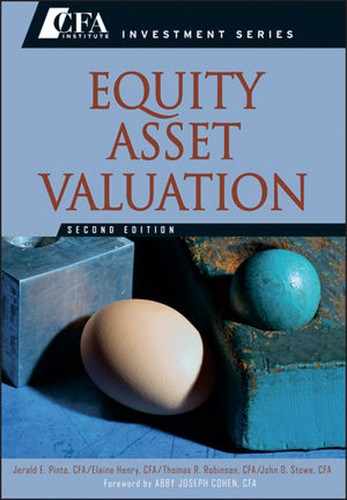CHAPTER 4
FREE CASH FLOW VALUATION
LEARNING OUTCOMES
After completing this chapter, you will be able to do the following :
• Define and interpret free cash flow to the firm (FCFF) and free cash flow to equity (FCFE).
• Describe, compare, and contrast the FCFF and FCFE approaches to valuation.
• Contrast the ownership perspective implicit in the FCFE approach to the ownership perspective implicit in the dividend discount approach.
• Discuss the appropriate adjustments to net income, earnings before interest and taxes (EBIT), earnings before interest, taxes, depreciation, and amortization (EBITDA), and cash flow from operations (CFO) to calculate FCFF and FCFE.
• Calculate FCFF and FCFE when given a company’s financial statements prepared according to International Financial Reporting Standards (IFRS) or U.S. generally accepted accounting principles (GAAP).
• Discuss approaches for forecasting FCFF and FCFE.
• Contrast the recognition of value in the FCFE model to the recognition of value in dividend discount models.
• Explain how dividends, share repurchases, share issues, and changes in leverage may affect FCFF and FCFE.
• Critique the use of net income and EBITDA as proxies for cash flow in valuation.
• Discuss the single -stage (stable -growth), two -stage, and three -stage FCFF and FCFE models (including assumptions) and explain the company characteristics that would justify the use of each model.
• Calculate the value of a company by using the stable-growth, two-stage, and three-stage FCFF and FCFE models.
• Explain how sensitivity analysis can be used in FCFF and FCFE valuations.
• Discuss approaches for calculating the terminal value in a multistage valuation model.
• Describe the characteristics of companies for which the FCFF model is preferred to the FCFE model.
1. INTRODUCTION TO FREE CASH FLOWS
Discounted cash flow (DCF) valuation views the intrinsic value of a security as the present value of its expected future cash flows. When applied to dividends, the DCF model is the discounted dividend approach or dividend discount model (DDM). This chapter extends DCF analysis to value a company and its equity securities by valuing free cash flow to the firm (FCFF) and free cash flow to equity (FCFE). Whereas dividends are the cash flows actually paid to stockholders, free cash flows are the cash flows available for distribution to shareholders.
Unlike dividends, FCFF and FCFE are not readily available data. Analysts need to compute these quantities from available financial information, which requires a clear understanding of free cash flows and the ability to interpret and use the information correctly. Forecasting future free cash flows is also a rich and demanding exercise. The analyst’s understanding of a company’s financial statements, its operations, its financing, and its industry can pay real “dividends” as he addresses that task. Many analysts consider free cash flow models to be more useful than DDMs in practice. Free cash flows provide an economically sound basis for valuation.
Analysts like to use free cash flow as the return (either FCFF or FCFE) whenever one or more of the following conditions is present:
• The company does not pay dividends.
• The company pays dividends but the dividends paid differ significantly from the company’s capacity to pay dividends.
• Free cash flows align with profitability within a reasonable forecast period with which the analyst is comfortable.
• The investor takes a control perspective. With control comes discretion over the uses of free cash flow. If an investor can take control of the company (or expects another investor to do so), dividends may be changed substantially; for example, they may be set at a level approximating the company’s capacity to pay dividends. Such an investor can also apply free cash flows to uses such as servicing the debt incurred in an acquisition.
Common equity can be valued directly by using FCFE or indirectly by first using an FCFF model to estimate the value of the firm and then subtracting the value of non-common-stock capital (usually debt) from FCFF to arrive at an estimate of the value of equity. The purpose of this chapter is to develop the background required to use the FCFF or FCFE approaches to value a company’s equity.
Section 2 defines the concepts of free cash flow to the firm and free cash flow to equity and then presents the two valuation models based on discounting of FCFF and FCFE. We also explore the constant-growth models for valuing FCFF and FCFE, which are special cases of the general models, in this section. After reviewing the FCFF and FCFE valuation process in Section 2, we turn in Section 3 to the vital task of calculating and forecasting FCFF and FCFE. Section 4 explains multistage free cash flow valuation models and presents some of the issues associated with their application. Analysts usually value operating assets and nonoperating assets separately and then combine them to find the total value of the firm, an approach described in Section 5.
2. FCFF AND FCFE VALUATION APPROACHES
The purpose of this section is to provide a conceptual understanding of free cash flows and the valuation models based on them. A detailed accounting treatment of free cash flows and more complicated valuation models follow in subsequent sections.
2.1. Defining Free Cash Flow
Free cash flow to the firm is the cash flow available to the company’s suppliers of capital after all operating expenses (including taxes) have been paid and necessary investments in working capital (e.g., inventory) and fixed capital (e.g., equipment) have been made. FCFF is the cash flow from operations minus capital expenditures. A company’s suppliers of capital include common stockholders, bondholders, and sometimes, preferred stockholders. The equations analysts use to calculate FCFF depend on the accounting information available.
Free cash flow to equity is the cash flow available to the company’s holders of common equity after all operating expenses, interest, and principal payments have been paid and necessary investments in working and fixed capital have been made. FCFE is the cash flow from operations minus capital expenditures minus payments to (and plus receipts from) debt holders.
The way in which free cash flow is related to a company’s net income, cash flow from operations, and measures such as EBITDA (earnings before interest, taxes, depreciation, and amortization) is important: The analyst must understand the relationship between a company’s reported accounting data and free cash flow in order to forecast free cash flow and its expected growth. Although a company reports cash flow from operations (CFO) on the statement of cash flows, CFO is not free cash flow. Net income and CFO data can be used, however, in determining a company’s free cash flow.
The advantage of FCFF and FCFE over other cash flow concepts is that they can be used directly in a DCF framework to value the firm or to value equity. Other cash flow- or earnings-related measures, such as CFO, net income, EBIT, and EBITDA, do not have this property because they either double-count or omit cash flows in some way. For example, EBIT and EBITDA are before-tax measures, and the cash flows available to investors (in the firm or in the equity of the firm) must be after tax. From the stockholders’ perspective, EBITDA and similar measures do not account for differing capital structures (the after-tax interest expenses or preferred dividends) or for the funds that bondholders supply to finance investments in operating assets. Moreover, these measures do not account for the reinvestment of cash flows that the company makes in capital assets and working capital to maintain or maximize the long-run value of the firm.
Using free cash flow in valuation is more challenging than using dividends because in forecasting free cash flow, the analyst must integrate the cash flows from the company’s operations with those from its investing and financing activities. Because FCFF is the after-tax cash flow going to all suppliers of capital to the firm, the value of the firm is estimated by discounting FCFF at the weighted average cost of capital (WACC). An estimate of the value of equity is then found by subtracting the value of debt from the estimated value of the firm. The value of equity can also be estimated directly by discounting FCFE at the required rate of return for equity (because FCFE is the cash flow going to common stockholders, the required rate of return on equity is the appropriate risk -adjusted rate for discounting FCFE).
The two free cash flow approaches, indirect and direct, for valuing equity should theoretically yield the same estimates if all inputs reflect identical assumptions. An analyst may prefer to use one approach rather than the other, however, because of the characteristics of the company being valued. For example, if the company’s capital structure is relatively stable, using FCFE to value equity is more direct and simpler than using FCFF. The FCFF model is often chosen, however, in two other cases:
1. A levered company with negative FCFE. In this case, working with FCFF to value the compan.y’s equity might be easiest. The analyst would discount FCFF to find the present value of operating assets (adding the value of excess cash and marketable securities and of any other significant nonoperating assets85 to get total firm value) and then subtract the market value of debt to obtain an estimate of the intrinsic value of equity.
2. A levered company with a changing capital structure. First, if historical data are used to forecast free cash flow growth rates, FCFF growth might reflect fundamentals more clearly than does FCFE growth, which reflects fluctuating amounts of net borrowing. Second, in a forward-looking context, the required return on equity might be expected to be more sensitive to changes in financial leverage than changes in the WACC, making the use of a constant discount rate difficult to justify.
Specialized DCF approaches are also available to facilitate the equity valuation when the capital structure is expected to change.86
In the following, we present the general form of the FCFF valuation model and the FCFE valuation model.
2.2. Present Value of Free Cash Flow
The two distinct approaches to using free cash flow for valuation are the FCFF valuation approach and the FCFE valuation approach. The general expressions for these valuation models are similar to the expression for the general dividend discount model. In the DDM, the value of a share of stock equals the present value of forecasted dividends from time 1 through infinity discounted at the required rate of return for equity.
2.2.1. Present Value of FCFF
The FCFF valuation approach estimates the value of the firm as the present value of future FCFF discounted at the weighted average cost of capital:
(4-1)
Because FCFF is the cash flow available to all suppliers of capital, using WACC to discount FCFF gives the total value of all of the firm’s capital. The value of equity is the value of the firm minus the market value of its debt:
(4-2)
Dividing the total value of equity by the number of outstanding shares gives the value per share.
The cost of capital is the required rate of return that investors should demand for a cash flow stream like that generated by the company being analyzed. WACC depends on the riskiness of these cash flows. The calculation and interpretation of WACC were discussed in Chapter 2—that is, WACC is the weighted average of the after (corporate) tax required rates of return for debt and equity, where the weights are the proportions of the firm’s total market value from each source, debt and equity. As an alternative, analysts may use the weights of debt and equity in the firm’s target capital structure when those weights are known and differ from market value weights. The formula for WACC is
 MV(Debt) and MV(Equity) are the current market values of debt and equity, not their book or accounting values, and the ratios of MV(Debt) and MV(Equity) to the total market value of debt plus equity define the weights in the WACC formula. The quantities rd (1 - Tax rate) and r are, respectively, the after-tax cost of debt and the after-tax cost of equity (in the case of equity, one could just write “cost of equity” because net income, the income belonging to equity, is after tax). In Equation 4-3, the tax rate is in principle the marginal corporate income tax rate.
MV(Debt) and MV(Equity) are the current market values of debt and equity, not their book or accounting values, and the ratios of MV(Debt) and MV(Equity) to the total market value of debt plus equity define the weights in the WACC formula. The quantities rd (1 - Tax rate) and r are, respectively, the after-tax cost of debt and the after-tax cost of equity (in the case of equity, one could just write “cost of equity” because net income, the income belonging to equity, is after tax). In Equation 4-3, the tax rate is in principle the marginal corporate income tax rate.
2.2.2. Present Value of FCFE
The value of equity can also be found by discounting FCFE at the required rate of return on equity, r:
(4-4)
Because FCFE is the cash flow remaining for equity holders after all other claims have been satisfied, discounting FCFE by r (the required rate of return on equity) gives the value of the firm’s equity. Dividing the total value of equity by the number of outstanding shares gives the value per share.
2.3. Single-Stage (Constant-Growth) FCFF and FCFE Models
In the DDM approach, the Gordon (constant- or stable-growth) model makes the assumption that dividends grow at a constant rate. The assumption that free cash flows grow at a constant rate leads to a single-stage (stable-growth) FCFF or FCFE model.87
2.3.1. Constant-Growth FCFF Valuation Model
Assume that FCFF grows at a constant rate, g, such that FCFF in any period is equal to FCFF in the previous period multiplied by (1 + g):
If FCFF grows at a constant rate,
(4-5)
Subtracting the market value of debt from the firm value gives the value of equity.
EXAMPLE 4-1 Using the Constant-Growth FCFF Valuation Model
Cagiati Enterprises has FCFF of 700 million Swiss francs (CHF) and FCFE of CHF620 million. Cagiati’s before-tax cost of debt is 5.7 percent, and its required rate of return for equity is 11.8 percent. The company expects a target capital structure consisting of 20 percent debt financing and 80 percent equity financing. The tax rate is 33.33 percent, and FCFF is expected to grow forever at 5.0 percent. Cagiati Enterprises has debt outstanding with a market value of CHF2.2 billion and has 200 million outstanding common shares.
1. What is Cagiati’s weighted average cost of capital?
2. What is the value of Cagiati’s equity using the FCFF valuation approach?
3. What is the value per share using this FCFF approach?
Solution to 1: From Equation 4-3, WACC is
WACC = 0.20(5.7%)(1 - 0.3333) +0.80(11.8%) = 10.2%
Solution to 2: The firm value of Cagiati Enterprises is the present value of FCFF discounted by using WACC. For FCFF growing at a constant 5 percent rate, the result is

The value of equity is the value of the firm minus the value of debt:
Equity value = 14,134.6 - 2,200 = CHF11,934.6 million
Solution to 3: Dividing CHF11,934.6 million by the number of outstanding shares gives the estimated value per share, V0:
2.3.2. Constant-Growth FCFE Valuation Model
The constant-growth FCFE valuation model assumes that FCFE grows at constant rate g. FCFE in any period is equal to FCFE in the preceding period multiplied by (1 + g):
The value of equity if FCFE is growing at a constant rate is
The discount rate is r, the required rate of return on equity. Note that the growth rate of FCFF and the growth rate of FCFE need not be and frequently are not the same.
In this section, we presented the basic ideas underlying free cash flow valuation and the simplest implementation, single-stage free cash flow models. The next section examines the precise definition of free cash flow and introduces the issues involved in forecasting free cash flow.
3. FORECASTING FREE CASH FLOW
Estimating FCFF or FCFE requires a complete understanding of the company and its financial statements. To provide a context for the estimation of FCFF and FCFE, we first use an extensive example to show the relationship between free cash flow and accounting measures of income.
For most of this section, we assume that the company has two sources of capital, debt and common stock. Once the concepts of FCFF and FCFE are understood for a company financed by using only debt and common stock, it is easy to incorporate preferred stock for the relatively small number of companies that actually use it (in Section 3.8 we incorporate preferred stock as a third source of capital).
3.1. Computing FCFF from Net Income
FCFF is the cash flow available to the company’s suppliers of capital after all operating expenses (including taxes) have been paid and operating investments have been made. The company’s suppliers of capital include bondholders and common shareholders (plus, occasionally, holders of preferred stock, which we ignore until later). Keeping in mind that a noncash charge is a charge or expense that does not involve the outlay of cash, we can write the expression for FCFF as follows:
FCFF = Net income available to common shareholders (NI) Plus: Net noncash charges (NCC) Plus: Interest expense x (1 - Tax rate) Less: Investment in fixed capital88 (FCInv) Less: Investment in working capital (WCInv)
This equation can be written more compactly as
Consider each component of FCFF. The starting point in Equation 4-7 is net income available to common shareholders—the bottom line in an income statement. It represents income after depreciation, amortization, interest expense, income taxes, and the payment of dividends to preferred shareholders (but not payment of dividends to common shareholders).
Net noncash charges represent an adjustment for noncash decreases and increases in net income. This adjustment is the first of several that analysts generally perform on a net basis. If noncash decreases in net income exceed the increases, as is usually the case, the adjustment is positive. If noncash increases exceed noncash decreases, the adjustment is negative. The most common noncash charge is depreciation expense. When a company purchases fixed capital, such as equipment, the balance sheet reflects a cash outflow at the time of the purchase. In subsequent periods, the company records depreciation expense as the asset is used. The depreciation expense reduces net income but is not a cash outflow. Depreciation expense is thus one (the most common) noncash charge that must be added back in computing FCFF. In the case of intangible assets, there is a similar noncash charge, amortization expense, which must be added back. Other noncash charges vary from company to company and are discussed in Section 3.3.
After-tax interest expense must be added back to net income to arrive at FCFF. This step is required because interest expense net of the related tax savings was deducted in arriving at net income and because interest is a cash flow available to one of the company’s capital providers (i.e., the company’s creditors). In the United States and many other countries, interest is tax deductible (reduces taxes) for the company (borrower) and taxable for the recipient (lender). As we explain later, when we discount FCFF, we use an after-tax cost of capital. For consistency, we thus compute FCFF by using the after-tax interest paid.89
Similar to after-tax interest expense, if a company has preferred stock, dividends on that preferred stock are deducted in arriving at net income available to common shareholders. Because preferred stock dividends are also a cash flow available to one of the company’s capital providers, this item is added back to arrive at FCFF. Further discussion of the effects of preferred stock is in Section 3.8.
Investments in fixed capital represent the outflows of cash to purchase fixed capital necessary to support the company’s current and future operations. These investments are capital expenditures for long-term assets, such as the property, plant, and equipment (PP&E) necessary to support the company’s operations. Necessary capital expenditures may also include intangible assets, such as trademarks. In the case of cash acquisition of another company instead of a direct acquisition of PP&E, the cash purchase amount can also be treated as a capital expenditure that reduces the company’s free cash flow (note that this treatment is conservative because it reduces FCFF). In the case of large acquisitions (and all noncash acquisitions), analysts must take care in evaluating the impact on future free cash flow. If a company receives cash in disposing of any of its fixed capital, the analyst must deduct this cash in calculating investment in fixed capital. For example, suppose we had a sale of equipment for $100,000. This cash inflow would reduce the company’s cash outflows for investments in fixed capital.
The company’s cash flow statement is an excellent source of information on capital expenditures as well as on sales of fixed capital. Analysts should be aware that some companies acquire fixed capital without using cash—for example, through an exchange for stock or debt. Such acquisitions do not appear in a company’s cash flow statement but, if material, must be disclosed in the footnotes. Although noncash exchanges do not affect historical FCFF, if the capital expenditures are necessary and may be made in cash in the future, the analyst should use this information in forecasting future FCFF.
The final point to cover is the important adjustment for net increases in working capital. This adjustment represents the net investment in current assets (such as accounts receivable) less current liabilities (such as accounts payable). Analysts can find this information by examining either the company’s balance sheet or its cash flow statement.
Although working capital is often defined as current assets minus current liabilities, working capital for cash flow and valuation purposes is defined to exclude cash and short-term debt (which includes notes payable and the current portion of long-term debt). When finding the net increase in working capital for the purpose of calculating free cash flow, we define working capital to exclude cash and cash equivalents as well as notes payable and the current portion of long-term debt. Cash and cash equivalents are excluded because a change in cash is what we are trying to explain. Notes payable and the current portion of long-term debt are excluded because they are liabilities with explicit interest costs that make them financing items rather than operating items.
Example 4-2 shows all of the adjustments to net income required to find FCFF.
EXAMPLE 4-2 Calculating FCFF from Net Income
Cane Distribution, Inc., incorporated on 31 December 2007 with initial capital infusions of $224,000 of debt and $336,000 of common stock, acts as a distributor of industrial goods. The company managers immediately invested the initial capital in fixed capital of $500,000 and working capital of $60,000. Working capital initially consisted solely of inventory. The fixed capital consisted of nondepreciable property of $50,000 and depreciable property of $450,000. The depreciable property has a 10-year useful life with no salvage value. Exhibits 4-1, 4-2, and 4-3 provide Cane’s financial statements for the three years following incorporation. Starting with net income, calculate Cane’s FCFF for each year.
EXHIBIT 4-1 Cane Distribution, Inc. Income Statement (in thousands)
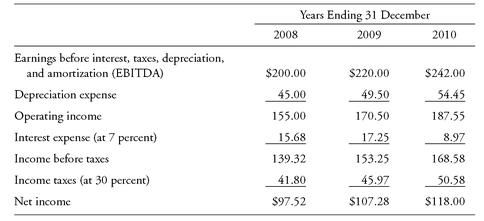
EXHIBIT 4-2 Cane Distribution, Inc. Balance Sheet (in thousands)
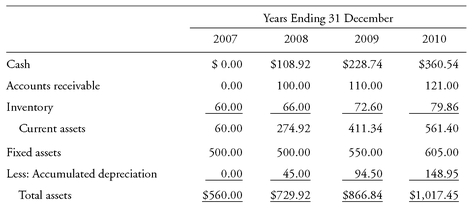
EXHIBIT 4-3 Cane Distribution, Inc. Working Capital (in thousands)
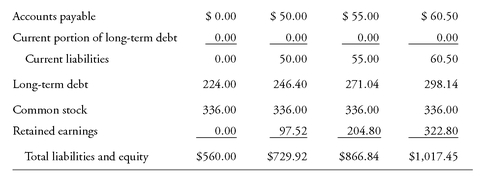
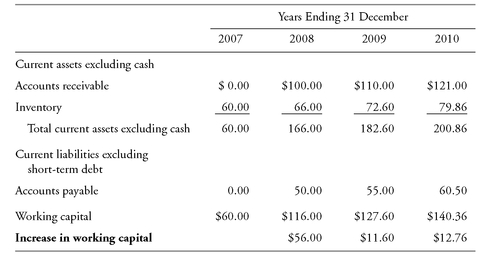
Solution: Following the logic in Equation 4-7, we calculate FCFF from net income as follows: We add noncash charges (here, depreciation) and after-tax interest expense to net income, then subtract the investment in fixed capital and the investment in working capital. The format for presenting the solution follows the convention that parentheses around a number indicate subtraction. The calculation follows (in thousands):
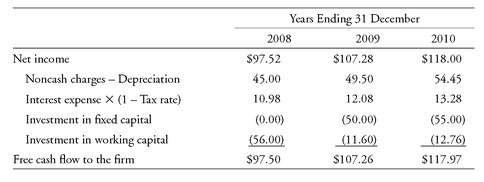
3.2. Computing FCFF from the Statement of Cash Flows
FCFF is cash flow available to all providers of capital (debt and equity). Analysts frequently use cash flow from operations, taken from the statement of cash flows, as a starting point to compute free cash flow because CFO incorporates adjustments for noncash expenses (such as depreciation and amortization) as well as for net investments in working capital.
In a statement of cash flows, cash flows are separated into three components: cash flow from operating activities (or cash flow from operations), cash flow from investing activities, and cash flow from financing activities. Cash flow from operations is the net amount of cash provided by the company’s operating activities. The operating section of the cash flow statement shows such cash flows as cash received from customers and cash paid to suppliers. Cash flow from investing activities includes the company’s investments in (or sales of) long-term assets—for example, PP&E and long-term investments in other companies. Cash flow from financing activities relates to the company’s activities in raising or repaying capital. International Financial Reporting Standards (IFRS) allow the company to classify interest paid as either an operating or financing activity. Furthermore, IFRS allow dividends paid to be classified as either an operating or financing activity. Interestingly, under U.S. generally accepted accounting principles (GAAP), interest expense paid to providers of debt capital must be classified as part of cash flow from operations (as is interest income) but payment of dividends to providers of equity capital is classified as a financing activity.
Exhibit 4-4 summarizes IFRS and U.S. GAAP treatment of interest and dividends.
EXHIBIT 4-4 IFRS versus U.S. GAAP Treatment of Interest and Dividends

To estimate FCFF by starting with CFO, we must recognize the treatment of interest paid. If the after-tax interest expense was taken out of net income and out of CFO, as with U.S. GAAP, then after-tax interest expense must be added back to get FCFF. In the case of U.S. GAAP, FCFF can be estimated as follows:


To reiterate, the after-tax interest expense is added back because it was previously taken out of net income. The investment in working capital does not appear in Equation 4-8 because CFO already includes investment in working capital. Example 4-3 illustrates the use of CFO to calculate FCFF. In this example, the calculation of CFO begins with calculating net income, an approach known as the indirect method.90
EXAMPLE 4-3 Calculating FCFF from CFO
Use the information from the statement of cash flows given in Exhibit 4-5 to calculate FCFF for the three years 2008-2010. The tax rate (as given in Exhibit 4-1) is 30 percent.
EXHIBIT 4-5 Cane Distribution, Inc. Statement of Cash Flows: Indirect Method (in thousands)
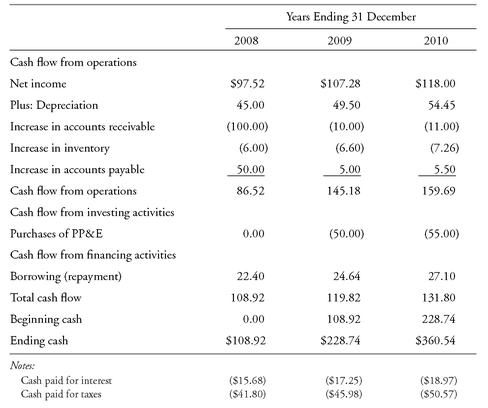
Solution: As shown in Equation 4-8, FCFF equals CFO plus after-tax interest minus the investment in fixed capital:

3.3. Noncash Charges
The best place to find historical noncash charges is in the company’s statement of cash flows. If an analyst wants to use an add-back method, as in FCFF = NI + NCC + Int(1 - Tax rate) - FCInv - WCInv, the analyst should verify the noncash charges to ensure that the FCFF estimate provides a reasonable basis for forecasting. For example, restructuring charges may involve cash expenditures and noncash charges. Severance pay for laid-off employees could be a cash restructuring charge, but a write-down in the value of assets as part of a restructuring charge is a noncash item. Example 4-4 illustrates noncash restructuring charges that must be added back to net income to obtain CFO. Note in the example that (noncash) gains from the sale of assets in restructuring are subtracted from net income to obtain CFO.
EXAMPLE 4-4 An Examination of Noncash Charges
Alberto-Culver Company (NYSE: ACV) develops, manufactures, distributes, and markets branded beauty care products and branded food and household products in more than 100 countries. Jane Everett wants to value Alberto-Culver by using the FCFF method. She collects information from the company’s 10-K for the fiscal year ended 30 September 2007.
Note that the cash flow statement in Exhibit 4-6 uses a presentation convention that follows the logic that “minus a minus equals a plus,” so in this convention, “Less: . . . 50” means “subtract 50” and “Less: . . . (50)” means “add 50.” An analyst may also encounter in practice, however, “Less: . . . (50)” interpreted as “subtract 50.”
EXHIBIT 4-6 Consolidated Statements of Cash Flows Alberto-Culver Company and Subsidiaries (in US$ thousands)
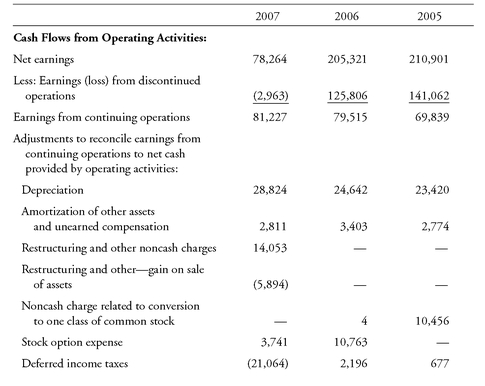
Cash effects of changes in (excluding acquisitions and divestitures):
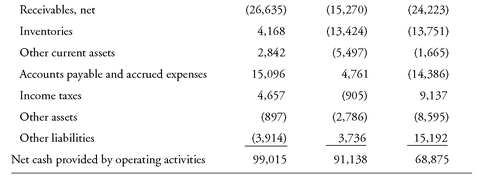
Everett notices that the reconciliation amounts in the cash flow statement for restructuring charges differ from the $34,645 restructuring charge recorded in the income statement. She finds the following discussion of restructuring charges in the management discussion and analysis (MD&A) section (Exhibit 4-7).
EXHIBIT 4-7 Excerpt from Management Discussion and Analysis
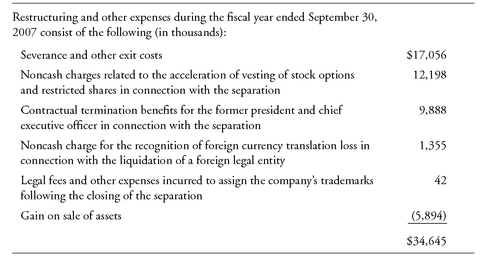
Severance and Other Exit Costs
On November 27, 2006, the company committed to a plan to terminate employees as part of a reorganization following the separation. In connection with this reorganization plan, on December 1, 2006 the company announced that it expects to close its manufacturing facility in Dallas, Texas. The company’s worldwide workforce is being reduced by approximately 225 employees as a result of the reorganization plan, including 125 employees from the Dallas, Texas manufacturing facility. The changes primarily affect corporate functions or the Consumer Packaged Goods business segment. The company expects to record additional pre-tax restructuring charges of approximately $1.5 million related to this plan in fiscal year 2008, primarily during the first half. These amounts exclude the effect of the sale of the manufacturing facility in Dallas, Texas. Cash payments related to this plan are expected to be substantially completed by the end of the second quarter of fiscal year 2008.
The following table reflects the activity related to the restructuring plan during the fiscal year ended September 30, 2007 (in thousands):

Using the information about Alberto-Culver provided, answer the following questions:
1. Why is there a difference in the amount shown for restructuring charges in the income statement and the amount shown for restructuring charges in the cash flow statement?
2. How should the restructuring charges be treated when forecasting future cash flows?
Solution to 1: The difference between restructuring charges in the income statement and restructuring charges in the cash flow statement arises because some of the restructuring charges were paid in cash and others were not. The cash flow statement shows the noncash restructuring charges ($14,053) as an amount added back to net income in the process of arriving at net cash provided by operating activities.
Note that Exhibit 4-7 discloses two noncash charges, which total $12,198 + $1,355 = $13,553, but the statement of cash flows shows restructuring and other noncash charges of $14,053. The MD&A provides no explanation for the balance of $14,053 - $13,553 = $500; thus, the MD&A disclosure of information is incomplete.
Solution to 2: Restructuring charges are generally unpredictable and are not typically part of a forecast. In Alberto-Culver’s case, however, $2,724 of restructuring-related liabilities remain (consisting mostly of liabilities for severance pay), which the company expects to pay in early 2008. Therefore, the forecast for 2008 should reflect these cash expenditures that will be made.
Noncash restructuring charges may also cause an increase in net income in some circumstances—for example, when a company reverses part or all of a previous accrual. Gains and losses (e.g., of operating assets) are another noncash item that may increase or decrease net noncash charges. If a company sells a piece of equipment with a book value of €60,000 for €100,000, it reports the €40,000 gain as part of net income. The €40,000 gain is not a cash flow, however, and must be subtracted in arriving at FCFF. Note that the €100,000 is a cash flow and is part of the company’s net investment in fixed capital. A loss reduces net income and thus must be added back in arriving at FCFF. Aside from depreciation, gains and losses are the most commonly seen noncash charges that require an adjustment to net income. Analysts should examine the company’s cash flow statement to identify items particular to a company and to determine what adjustments the analyst might need to make for the accounting numbers to be useful for forecasting purposes.
Exhibit 4-8 summarizes the common noncash charges that affect net income and indicates for each item whether to add it to or subtract it from net income in arriving at FCFF.
EXHIBIT 4-8 Noncash Items and FCFF
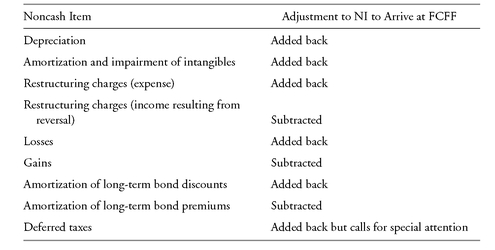
The item “Deferred taxes” requires special attention because deferred taxes result from differences in the timing of reporting income and expenses in the company’s financial statements and the company’s tax return. The income tax expense deducted in arriving at net income for financial reporting purposes is not the same as the amount of cash taxes paid. Over time, these differences between book income and taxable income should offset each other and have no impact on aggregate cash flows. Generally, if the analyst’s purpose is forecasting and, therefore, identifying the persistent components of FCFF, then the analyst should not add back deferred tax changes that are expected to reverse in the near future. In some circumstances, however, a company may be able to consistently defer taxes until a much later date. If a company is growing and has the ability to indefinitely defer its tax liability, adding back deferred taxes to net income is warranted. Nevertheless, an acquirer must be aware that these taxes may be payable at some time in the future.
Companies often record expenses (e.g., restructuring charges) for financial reporting purposes that are not deductible for tax purposes. In this case, current tax payments are higher than taxes reported in the income statement, resulting in a deferred tax asset and a subtraction from net income to arrive at cash flow in the cash flow statement. If the deferred tax asset is expected to reverse in the near future (e.g., through tax depreciation deductions), to avoid underestimating future cash flows, the analyst should not subtract the deferred tax asset in a cash flow forecast. If the company is expected to have these charges on a continual basis, however, a subtraction that will lower the forecast of future cash flows is warranted.
Employee share-based compensation (stock options) provides another challenge to the forecaster. Under IFRS and U.S. GAAP, companies must record in the income statement an expense for options provided to employees. The granting of options themselves does not result in a cash outflow and is thus a noncash charge; however, the granting of options has long-term cash flow implications. When the employee exercises the option, the company receives some cash related to the exercise price of the option at the strike price. This cash flow is considered a financing cash flow. Also, in some cases, a company receives a tax benefit from issuing options, which could increase operating cash flow but not net income. Both IFRS and U.S. GAAP require that a portion of the tax effect be recorded as a financing cash flow rather than an operating cash flow in the cash flow statement. Analysts should review the cash flow statement and footnotes to determine the impact of options on operating cash flows. If these cash flows are not expected to persist in the future, analysts should not include them in their forecasts of cash flows. Analysts should also consider the impact of stock options on the number of shares outstanding. When computing equity value, analysts may want to use the number of shares expected to be outstanding (based on the exercise of employee stock options) rather than the number currently outstanding.
Example 4-5 illustrates that when forecasting cash flows for valuation purposes, analysts should consider the sustainability of historical working capital effects on free cash flow.
EXAMPLE 4-5 Sustainability of Working Capital Effects on Free Cash Flow
Ryanair Holdings PLC (LSE: RYAOF) operates a low-fares scheduled passenger airline serving short-haul, point-to-point routes between Ireland, the United Kingdom, Continental Europe, and Morocco. The operating activities section of its cash flow statement and a portion of the investing activities section are presented in Exhibit 4-9. The cash flow statement was prepared in accordance with IFRS.
EXHIBIT 4-9 Ryan Holdings PLC Excerpt from Cash Flow Statement (euro in thousands)
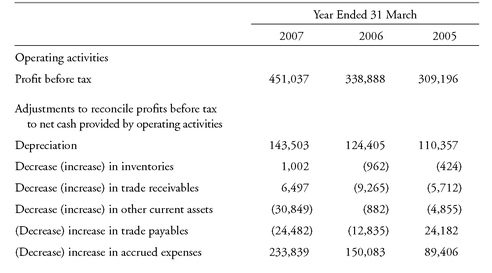
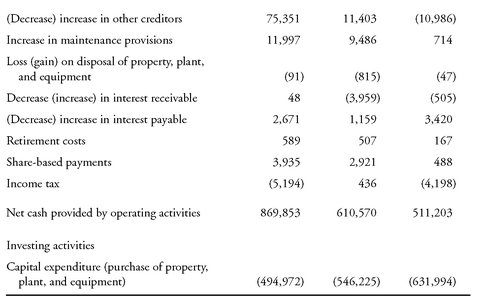
Analysts predict that as Ryanair grows in coming years, depreciation expense will increase substantially.
Based on the information given, address the following:
1. Contrast reported depreciation expense to reported capital expenditures and describe the implications of future growth in depreciation expense (all else being equal) for future net income and future cash from operating activities.
2. Explain the effects on free cash flow to equity of changes in 2007 in working capital accounts, such as inventory, accounts receivable, and accounts payable, and comment on the long-term sustainability of such changes.
Solution to 1: In the 2005-2007 period, depreciation expense was a small fraction of capital expenditures. For example, in 2007, capital expenditures of €495 million were 3.5 times as large as the €143.5 million depreciation expense.
In calculating net income, depreciation is a deduction. Therefore, as depreciation expense increases in coming years, net income will decrease. Specifically, net income will be reduced by (Depreciation expense) x (1 - Tax rate). In calculating CFO, however, depreciation is added back in full to net income. The difference between depreciation expense—the amount added back to net income to calculate CFO—and the amount by which net income is reduced by depreciation expense is (Tax rate) x (Depreciation expense), which represents a positive increment to CFO. Thus, the projected increase in depreciation expense is a negative for future net income but a positive for future CFO. (At worst, if the company operates at a loss, depreciation is neutral for CFO.)
Solution to 2: In 2007, the decreases in inventory and accounts receivable (“trade receivables”) resulted in positive adjustments to net income (i.e., the changes increased cash flow relative to net income). The adjustments are positive because decreases in these accounts (the sale of inventory and collection of accounts receivable) are a source of cash. On the current liabilities side, the increase in accrued expenses and increase in “other creditors” are also added back to net income and are sources of cash because such increases represent increased amounts for which cash payments have yet to be made. The negative adjustment for accounts payable, however, indicates that the accounts payable balance declined in 2007: Ryanair spent cash to reduce the amount of trade credit being extended to it by suppliers during the year, resulting in a reduction in cash. Because CFO is a component of FCFE, the items that had a positive (negative) effect on CFO also have a positive (negative) effect on FCFE.
Declining balances for assets, such as inventory, or for liabilities, such as accounts payable, are not sustainable indefinitely. In the extreme case, the balance declines to zero and no further reduction is possible. Given the growth in its net income and the expansion of PP&E evidenced by capital expenditures, Ryanair appears to be growing and investors should expect its working capital requirements to grow accordingly. Thus, the components of 2007 FCFE attributable to reduction in inventory and accounts receivable balances are probably not relevant in forecasting future FCFE.
3.4. Computing FCFE from FCFF
FCFE is cash flow available to equity holders only. To find FCFE, therefore, we must reduce FCFF by the after-tax value of interest paid to debt holders and add net borrowing (which is debt issued less debt repaid over the period for which one is calculating free cash flow):


As Equation 4-9 shows, FCFE is found by starting from FCFF, subtracting after-tax interest expenses, and adding net new borrowing. The analyst can also find FCFF from FCFE by making the opposite adjustments—by adding after-tax interest expenses and subtracting net borrowing: FCFF = FCFE + Int(1 - Tax rate) - Net borrowing.
Exhibit 4-10 uses the values for FCFF for Cane Distribution calculated in Example 4-3 to show the calculation of FCFE when starting with FCFF. To calculate FCFE in this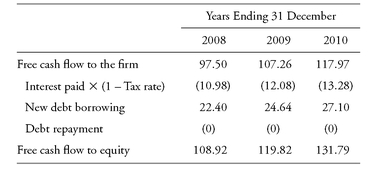 manner, we subtract after-tax interest expense from FCFF and then add net borrowing (equal to new debt borrowing minus debt repayment).
manner, we subtract after-tax interest expense from FCFF and then add net borrowing (equal to new debt borrowing minus debt repayment).
EXHIBIT 4-10 Calculating FCFE from FCFF

To reiterate, FCFE is the cash flow available to common stockholders—the cash flow remaining after all operating expenses (including taxes) have been paid, capital investments have been made, and other transactions with other suppliers of capital have been carried out. The company’s other capital suppliers include creditors, such as bondholders, and preferred stockholders. The cash flows (net of taxes) that arise from transactions with creditors and preferred stockholders are deducted from FCFF to arrive at FCFE.
FCFE is the amount that the company can afford to pay out as dividends. In actuality, for various reasons companies often pay out substantially more or substantially less than FCFE, so FCFE often differs from dividends paid. One reason for this difference is that the dividend decision is a discretionary decision of the board of directors. Most corporations manage their dividends; they prefer to raise them gradually over time, partly because they do not want to have to cut dividends. Many companies raise dividends slowly even when their earnings are increasing rapidly, and companies often maintain their current dividends even when their profitability has declined. Consequently, earnings are much more volatile than dividends.
In Equations 4-7 and 4-8, we show the calculation of FCFF starting with, respectively, net income and cash flow from operations. As Equation 4-9 shows, FCFE = FCFF - Int(1 - Tax rate) + Net borrowing. By subtracting after-tax interest expense and adding net borrowing to Equations 4-7 and 4-8, we have equations to calculate FCFE starting with, respectively, net income and CFO:
Example 4-6 illustrates how to adjust net income or CFO to find FCFF and FCFE.
EXAMPLE 4-6 Adjusting Net Income or CFO to Find FCFF and FCFE
The balance sheet, income statement, and statement of cash flows for the Pitts Corporation are shown in Exhibit 4-11. Note that the statement of cash flows follows a convention according to which the positive numbers of $400 million and $85 million for “cash used for investing activities” and “cash used for financing activities,” respectively, indicate outflows and thus amounts to be subtracted. Analysts will also encounter a convention in which the value “(400)” for “cash provided by (used for) investing activities” would be used to indicate a subtraction of $400.
EXHIBIT 4-11 Financial Statements for Pitts Corporation (in millions, except for per-share data)


1. Calculate FCFF starting with the net income figure.
2. Calculate FCFE starting from the FCFF calculated in question 1.
3. Calculate FCFE starting with the net income figure.
4. Calculate FCFE starting with CFO.
5. Calculate FCFE starting with CFO.
Solution to 1: The analyst can use Equation 4-7 to find FCFF from net income (amounts are in millions).
| Net income available to common shareholders | $240 |
| Plus: Net noncash charges | 300 |
| Plus: Interest expense x (1 - Tax rate) | 60 |
| Less: Investment in fixed capital | 400 |
| Less : Investment in working capital | 45 |
| Free cash flow to the firm | $155 |
In the format shown and throughout the solutions, “Less: . . . x” is interpreted as “subtract x.”
This equation can also be written as
Some of these items need explanation. Capital spending is $400 million, which is the increase in gross fixed assets shown on the balance sheet and in capital expenditures shown as an investing activity in the statement of cash flows. The increase in working capital is $45 million, which is the increase in accounts receivable of $40 million ($600 million - $560 million) plus the increase in inventories of $30 million ($440 million - $410 million) minus the increase in accounts payable of $15 million ($300 million - $285 million) minus the increase in accrued taxes and expenses of $10 million ($150 million - $140 million). When finding the increase in working capital, we ignore cash because the change in cash is what we are calculating. We also ignore short-term debt, such as notes payable, because such debt is part of the capital provided to the company and is not considered an operating item. The after-tax interest cost is the interest expense times (1 - Tax rate): $100 million (1 - 0.40) = $60 million. The values of the remaining items in Equation 4-7 can be taken directly from the financial statements.
Solution to 2: Finding FCFE from FCFF can be done with Equation 4-9.
| Free cash flow to the firm | $155 |
| Less: Interest expense x (1 - Tax rate) | 60 |
| Plus: Net borrowing | 75 |
| Free cash flow to equity | $170 |
Or by using the equation

Solution to 3: The analyst can use Equation 4-10 to find FCFE from NI.
| Net income available to common shareholders | $240 |
| Plus: Net noncash charges | 300 |
| Less: Investment in fixed capital | 400 |
| Less: Investment in working capital | 45 |
| Plus: Net borrowing | 75 |
| Free cash flow to equity | $170 |
Or by using the equation
Because notes payable increased by $50 million ($250 million - $200 million) and long-term debt increased by $25 million ($890 million - $865 million), net borrowing is $75 million.
Solution to 4: Equation 4-8 can be used to find FCFF from CFO.
or
| Cash flow from operations | $495 |
| Plus: Interest expense x (1 - Tax rate) | 60 |
| Less: Investment in fixed capital | 400 |
| Free cash flow to the firm | $155 |

Solution to 5: Equation 4-11 can be used to find FCFE from CFO.
or
| Cash flow from operations | $495 |
| Less: Investment in fixed capital | 400 |
| Plus: Net borrowing | 75 |
| Free cash flow to equity | $170 |
FCFE is usually less than FCFF. In this example, however, FCFE ($170 million) exceeds FCFF ($155 million) because external borrowing was large during this year.
3.5. Finding FCFF and FCFE from EBIT or EBITDA
FCFF and FCFE are most frequently calculated from a starting basis of net income or CFO (as shown in Sections 3.1 and 3.2). Two other starting points are EBIT and EBITDA from the income statement.
To show the relationship between EBIT and FCFF, we start with Equation 4-7 and assume that the only noncash charge (NCC) is depreciation (Dep):
Net income (NI) can be expressed as
Substituting this equation for NI in Equation 4-7, we have
To get FCFF from EBIT, we multiply EBIT by (1 - Tax rate), add back depreciation, and then subtract the investments in fixed capital and working capital.
The relationship between FCFF and EBITDA can also be easily shown. Net income can be expressed as
Substituting this equation for NI in Equation 4-7 results in
FCFF equals EBITDA times (1 - Tax rate) plus depreciation times the tax rate minus investments in fixed capital and working capital. In comparing Equations 4-12 and 4-13, note the difference in how depreciation is handled.
Many adjustments for noncash charges that are required to calculate FCFF when starting from net income are not required when starting from EBIT or EBITDA. In the calculation of net income, many noncash charges are made after computing EBIT or EBITDA, so they do not need to be added back when calculating FCFF based on EBIT or EBITDA. Another important consideration is that some noncash charges, such as depreciation, are tax deductible. A noncash charge that affects taxes must be accounted for.
In summary, in calculating FCFF from EBIT or EBITDA, whether an adjustment for a noncash charge is needed depends on where in the income statement the charge has been deducted; furthermore, the form of any needed adjustment depends on whether the noncash charge is a tax-deductible expense.
We can also calculate FCFE (instead of FCFF) from EBIT or EBITDA. An easy way to obtain FCFE based on EBIT or EBITDA is to use Equation 4-12 (the expression for FCFF in terms of EBIT) or Equation 4-13 (the expression for FCFF in terms of EBITDA), respectively, and then subtract Int(1 - Tax rate) and add net borrowing, because FCFE is related to FCFF as follows (see Equation 4-9):
Example 4-7 uses the Pitts Corporation financial statements to find FCFF and FCFE from EBIT and EBITDA.
EXAMPLE 4-7 Adjusting EBIT and EBITDA to Find FCFF and FCFE
The Pitts Corporation (financial statements provided in Example 4-6) had EBIT of $500 million and EBITDA of $800 million in 2007. Show the adjustments that would be required to find FCFF and FCFE:
1. Starting from EBIT.
2. Starting from EBITDA.
Solution to 1: To get FCFF from EBIT using Equation 4-12, we carry out the following (in millions):
or
| EBIT(1 - Tax rate) = 500(1 - 0.40) | $300 |
| Plus: Net noncash charges | 300 |
| Less: Net investment in fixed capital | 400 |
| Less: Net increase in working capital | 45 |
| Free cash flow to the firm | $155 |
To obtain FCFE, make the appropriate adjustments to FCFF:
Solution to 2: To obtain FCFF from EBITDA using Equation 4-13, we do the following (in millions):
or
| EBITDA(1 - Tax rate) = $800(1 - 0.40) | $480 |
| Plus: Dep(Tax rate) = $300(0.40) | 120 |
| Less: Net investment in fixed capital | 400 |
| Less: Net increase in working capital | 45 |
| Free cash flow to the firm | $155 |
Again, to obtain FCFE, make the appropriate adjustments to FCFF:
3.6. FCFF and FCFE on a Uses-of-Free-Cash-Flow Basis
Prior sections illustrated the calculation of FCFF and FCFE from various income or cash flow starting points (e.g., net income or cash flow from operations). Those approaches to calculating free cash flow can be characterized as showing the sources of free cash flow. An alternative perspective examines the uses of free cash flow. In the context of calculating FCFF and FCFE, analyzing free cash flow on a uses basis serves as a consistency check on the sources calculation and may reveal information relevant to understanding a company’s capital structure policy or cash position.
In general, a firm has the following alternative uses of positive FCFF: (1) Retain the cash and thus increase the firm’s balances of cash and marketable securities; (2) use the cash for payments to providers of debt capital (i.e., interest payments and principal payments in excess of new borrowings); and (3) use the cash for payments to providers of equity capital (i.e., dividend payments and/or share repurchases in excess of new share issuances). Similarly, a firm has the following general alternatives for covering negative free cash flows: draw down cash balances, borrow additional cash, or issue equity.
The effects on the company’s capital structure of its transactions with capital providers should be noted. For a simple example, assume that free cash flows are zero and that the company makes no change to its cash balances. Obtaining cash via net new borrowings and using the cash for dividends or net share repurchases will increase the company’s leverage, whereas obtaining cash from net new share issuances and using that cash to make principal payments in excess of new borrowings will reduce leverage.
We calculate uses of FCFF as follows:
Uses of FCFF =
Increases (or minus decreases) in cash balances
Plus: Net payments to providers of debt capital, calculated as:
• Plus: Interest expense x (1 - Tax rate)
• Plus: Repayment of principal in excess of new borrowing (or minus new borrowing in excess of debt repayment if new borrowing is greater)
Plus: Payments to providers of equity capital, calculated as:
• Plus: Cash dividends
• Plus: Share repurchases in excess of share issuance (or minus new share issuance in excess of share repurchases if share issuance is greater)
Uses of FCFF must equal sources of FCFF as previously calculated.
Free cash flows to equity reflect free cash flows to the firm net of the cash used for payments to providers of debt capital. Accordingly, we can calculate FCFE as follows:
Uses of FCFE =
Plus: Increases (or minus decreases) in cash balances
Plus: Payments to providers of equity capital, calculated as:
• Plus: Cash dividends
• Plus: Share repurchases in excess of share issuance (or minus new share issuance in excess of share repurchases if share issuance is greater)
Again, the uses of FCFE must equal the sources of FCFE (calculated previously).
To illustrate the equivalence of sources and uses of FCFF and FCFE for the Pitts Corporation, whose financial statements are given in Exhibit 4-11 in Example 4-6, note the following for 2007:
• The increase in the balance of cash and equivalents was $10, calculated as $200 - $190.
• After-tax interest expense was $60, calculated as Interest expense x (1 - Tax rate) = $100 x (1 - 0.40).
• Net borrowing was $75, calculated as increase in borrowing minus repayment of debt: $50 (increase in notes payable) + $25 (increase in long-term debt).
• Cash dividends totaled $160.
• Share repurchases and issuance both equaled $0.
FCFF, previously calculated, was $155. Pitts Corporation used the FCFF as follows:
| In crease in balance of cash and cash equivalents | $10 |
| Plus: After-tax interest payments to providers of debt capital | $60 |
| Minus: New borrowing91 | ($75) |
| Plus: Payments of dividends to providers of equity capital | $160 |
| Plus: Share repurchases in excess of share issuances (or minus new share issuance in excess of share repurchases) | $0 |
| Total uses of FCFF | $155 |
FCFE, previously calculated, was $170. Pitts Corporation used the FCFE as follows:
| In crease in balance of cash and cash equivalents | $10 |
| Plus: Payments of dividends to providers of equity capital | $160 |
| Plus: Share repurchases in excess of share issuances (or minus new share issuance in excess of share repurchases) | $0 |
| Total uses of FCFE | $170 |
In summary, an analysis of the uses of free cash flows shows that Pitts Corporation was using free cash flows to manage its capital structure by increasing debt. The additional debt was not needed to cover capital expenditures; the statement of cash flows showed that the company’s operating cash flows of $495 were more than adequate to cover its capital expenditures of $400. Instead, the additional debt was used, in part, to make dividend payments to the company’s shareholders.
3.7. Forecasting FCFF and FCFE
Computing FCFF and FCFE from historical accounting data is relatively straightforward. In some cases, these data are used directly to extrapolate free cash flow growth in a single-stage free cash flow valuation model. On other occasions, however, the analyst may expect that the future free cash flows will not bear a simple relationship to the past. The analyst who wishes to forecast future FCFF or FCFE directly for such a company must forecast the individual components of free cash flow. This section extends our previous presentation on computing FCFF and FCFE to the more complex task of forecasting FCFF and FCFE.
One method for forecasting free cash flow involves applying some constant growth rate to a current level of free cash flow (possibly adjusted). The simplest basis for specifying the future growth rate is to assume that a historical growth rate will also apply to the future. This approach is appropriate if a company’s free cash flow has tended to grow at a constant rate and if historical relationships between free cash flow and fundamental factors are expected to continue. Example 4-8 asks that the reader apply this approach to the Pitts Corporation based on 2007 FCFF of $155 million as calculated in Examples 4-6 and 4-7.
EXAMPLE 4-8 Constant Growth in FCFF
Use Pitts Corporation data to compute its FCFF for the next three years. Assume that growth in FCFF remains at the historical levels of 15 percent per year. The answer is (in millions):

A more complex approach is to forecast the components of free cash flow. This approach is able to capture the complex relationships among the components. One popular method92 is to forecast the individual components of free cash flow: EBIT(1 - Tax rate), net noncash charges, investment in fixed capital, and investment in working capital. EBIT can be forecasted directly or by forecasting sales and the company’s EBIT margin based on an analysis of historical data and the current and expected economic environment. Similarly, analysts can base forecasts of capital needs on historical relationships between increases in sales and investments in fixed and working capital.
In this discussion, we illustrate a simple sales-based forecasting method for FCFF and FCFE based on the following major assumption:
Investment in fixed capital in excess of depreciation (FCInv - Dep) and investment in working capital (WCInv) both bear a constant relationship to forecast increases in the size of the company as measured by increases in sales.
In addition, for FCFE forecasting, we assume that the capital structure represented by the debt ratio (DR)—debt as a percentage of debt plus equity—is constant. Under that assumption, DR indicates the percentage of the investment in fixed capital in excess of depreciation (also called net new investment in fixed capital) and in working capital that will be financed by debt. This method involves a simplification because it considers depreciation as the only noncash charge, so the method does not work well when that approximation is not a good assumption.
If depreciation reflects the annual cost for maintaining the existing capital stock, the difference between fixed capital investment and depreciation—incremental FCInv—should be related to the capital expenditures required for growth. In this case, the following inputs are needed:
• Forecasts of sales growth rates.
• Forecasts of the after-tax operating margin (for FCFF forecasting) or profit margin (for FCFE forecasting).
• An estimate of the relationship of incremental FCInv to sales increases.
• An estimate of the relationship of WCInv to sales increases.
• An estimate of DR.
In the case of FCFF forecasting, FCFF is calculated by forecasting EBIT(1 - Tax rate) and subtracting incremental fixed capital expenditures and incremental working capital expenditures (see Rappaport 1997). To estimate FCInv and WCInv, we multiply their past proportion to sales increases by the forecasted sales increases. Incremental fixed capital expenditures as a proportion of sales increases are computed as follows:
Similarly, incremental working capital expenditures as a proportion of sales increases are
When depreciation is the only significant net noncash charge, this method yields the same results as the previous equations for estimating FCFF or FCFE. Rather than adding back all depreciation and subtracting all capital expenditures when starting with EBIT(1 - Tax rate), this approach simply subtracts the net capital expenditures in excess of depreciation.
Although the recognition may not be obvious, this approach recognizes that capital expenditures have two components: those expenditures necessary to maintain existing capacity (fixed capital replacement) and those incremental expenditures necessary for growth. In forecasting, the expenditures to maintain capacity are likely to be related to the current level of sales, and the expenditures for growth are likely to be related to the forecast of sales growth.
When forecasting FCFE, analysts often make an assumption that the financing of the company involves a target debt ratio. In this case, they assume that a specified percentage of the sum of (1) net new investment in fixed capital (new fixed capital minus depreciation expense) and (2) increase in working capital is financed based on a target DR. This assumption leads to a simplification of FCFE calculations. If we assume that depreciation is the only noncash charge, Equation 4-10, which is FCFE = NI + NCC - FCInv - WCInv + Net borrowing, becomes
Note that FCInv - Dep represents the incremental fixed capital expenditure net of depreciation. By assuming a target DR, we eliminated the need to forecast net borrowing and can use the expression
By using this expression, we do not need to forecast debt issuance and repayment on an annual basis to estimate net borrowing. Equation 4-14 then becomes

Equation 4-15 says that FCFE equals NI minus the amount of fixed capital expenditure (net of depreciation) and working capital investment that is financed by equity. Again for Equation 4-15, we have assumed that the only noncash charge is depreciation.
Examples 4-9 and 4-10 illustrate this sales-based method for forecasting free cash flow to the firm.
EXAMPLE 4-9 Free Cash Flow Tied to Sales
Carla Espinosa is an analyst following Pitts Corporation at the end of 2007. From the data in Example 4-6, she can see that the company’s sales for 2007 were $3,000 million, and she assumes that sales grew by $300 million from 2006 to 2007. Espinosa expects Pitts Corporation’s sales to increase by 10 percent per year thereafter. Pitts Corporation is a fairly stable company, so Espinosa expects it to maintain its historical EBIT margin and proportions of incremental investments in fixed and working capital. Pitts Corporation’s EBIT for 2007 is $500 million; its EBIT margin is 16.67 percent (500/3,000), and its tax rate is 40 percent.
Note from Pitts Corporation’s 2007 cash flow statement (Exhibit 4-11) the amount for “purchases of fixed assets” (i.e., capital expenditures) of $400 million and depreciation of $300 million. Thus, incremental fixed capital investment in 2007 was
Incremental working capital investment in the past year was
So, for every $100 increase in sales, Pitts Corporation invests $33.33 in new equipment in addition to replacement of depreciated equipment and $15 in working capital. Espinosa forecasts FCFF for 2008 as follows (dollars in millions):
| Sales | $3,300 | Up 10 percent |
| EBIT | 550 | 16.67 percent of sales |
| EBIT(1 - Tax rate) | 330 | Adjusted for 40 percent tax rate |
| Incremental FC | (100) | 33.33 percent of sales increase |
| Incremental WC | (45) | 15 percent of sales increase |
| FCFF | $185 |
This model can be used to forecast multiple periods and is flexible enough to allow varying sales growth rates, EBIT margins, tax rates, and rates of incremental capital increases.
EXAMPLE 4-10 Free Cash Flow Growth Tied to Sales Growth
Continuing her work, Espinosa decides to forecast FCFF for the next five years. She is concerned that Pitts Corporation will not be able to maintain its historical EBIT margin and that the EBIT margin will decline from the current 16.67 percent to 14.5 percent in the next five years. Exhibit 4-12 summarizes her forecasts.
EXHIBIT 4-12 Free Cash Flow Growth for Pitts Corporation (dollars in millions)
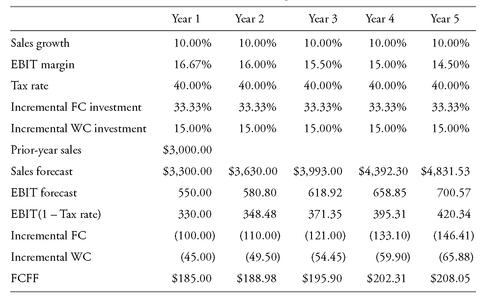
The model need not begin with sales; it could start with net income, cash flow from operations, or EBITDA.
A similar model can be designed for FCFE, as shown in Example 4-11. In the case of FCFE, the analyst should begin with net income and must also forecast any net new borrowing or net preferred stock issue.
EXAMPLE 4-11 Finding FCFE from Sales Forecasts
Espinosa decides to forecast FCFE for the year 2008. She uses the same expectations derived in Example 4-9. Additionally, she expects the following:
• The profit margin will remain at 8 percent (= 240/3,000).
• The company will finance incremental fixed and working capital investments with 50 percent debt—the target DR. Espinosa’s forecast for 2008 is as follows (dollars in millions):
| Sales | $3,300 | Up 10 percent |
| NI | 264 | 8.0 percent of sales |
| Incremental FC | (100) | 33.33 percent of sales increase |
| Incremental WC | (45) | 15 percent of sales increase |
| Net borrowing | 72.50 | (100 FCInv + 45 WCInv) x 50% |
| FCFE | $191.50 |
When the company being analyzed has significant noncash charges other than depreciation expense, the approach we have just illustrated will result in a less accurate estimate of FCFE than one obtained by forecasting all the individual components of FCFE. In some cases, the analyst will have specific forecasts of planned components, such as capital expenditures. In other cases, the analyst will study historical relationships, such as previous capital expenditures and sales levels, to develop a forecast.
3.8. Other Issues in Free Cash Flow Analysis
We have already presented a number of practical issues that arise in using free cash flow valuation models. Other issues relate to analyst adjustments to CFO, the relationship between free cash flow and dividends, and valuation with complicated financial structures.
3.8.1. Analyst Adjustments to CFO
Although many corporate financial statements are straightforward, some are not transparent (i.e., the quality of the reported numbers and of disclosures is not high). Sometimes, difficulties in analysis arise because the companies and their transactions are more complicated than the preceding Pitts Corporation example.
For instance, in many corporate financial statements, the changes in balance sheet items (the increase in an asset or the decrease in a liability) differ from the changes reported in the statement of cash flows. Similarly, depreciation in the statement of cash flows may differ from depreciation expense in the income statement. How do such problems arise?
Factors that can cause discrepancies between changes in balance sheet accounts and the changes reported in the statement of cash flows include acquisitions or divestitures and the presence of nondomestic subsidiaries. For example, an increase in an inventory account may result from purchases from suppliers (which is an operating activity) or from an acquisition or merger with another company that has inventory on its balance sheet (which is an investing activity). Discrepancies may also occur from currency translations of the earnings of nondomestic subsidiaries.
Because the CFO figure from the statement of cash flows may be contaminated by cash flows arising from financing and/or investing activities, when analysts use CFO in a valuation context, ideally they should remove such contaminations. The resulting analyst-adjusted CFO is then the starting point for free cash flow calculations.
3.8.2. Free Cash Flow versus Dividends and Other Earnings Components
Many analysts have a strong preference for free cash flow valuation models over dividend discount models. Although one type of model may have no theoretical advantage over another type, legitimate reasons to prefer one model can arise in the process of applying free cash flow models versus DDMs. First, many corporations pay no, or very low, cash dividends. Using a DDM to value these companies is difficult because they require forecasts about when dividends will be initiated, the level of dividends at initiation, and the growth rate or rates from that point forward. Second, dividend payments are at the discretion of the corporation’s board of directors. Therefore, they may imperfectly signal the company’s long-run profitability. Some corporations clearly pay dividends that are substantially less than their free cash flow, and others pay dividends that are substantially more. Finally, as mentioned earlier, dividends are the cash flow actually going to shareholders whereas free cash flow to equity is the cash flow available to be distributed shareholders without impairing the company’s value. If a company is being analyzed because it is a target for takeover, free cash flow is the appropriate cash flow measure; once the company is taken over, the new owners will have discretion over how free cash flow is used (including its distribution in the form of dividends).
We have defined FCFF and FCFE and presented alternative (equivalent) ways to calculate both of them. So the reader should have a good idea of what is included in FCFF or FCFE but may wonder why some cash flows are not included. Specifically, what impact do dividends, share repurchases, share issuance, or changes in leverage have on FCFF and FCFE? The simple answer is: not much. Recall the formulas for FCFF and FCFE: and
and
Notice that dividends and share repurchases and issuance are absent from the formulas. The reason is that FCFF and FCFE are the cash flows available to investors or to stockholders; dividends and share repurchases are uses of these cash flows. So the simple answer is that transactions between the company and its shareholders (through cash dividends, share repurchases, and share issuances) do not affect free cash flow. Leverage changes, such as the use of more debt financing, have some impact because they increase the interest tax shield (reduce corporate taxes because of the tax deductibility of interest) and reduce the cash flow available to equity. In the long run, the investing and financing decisions made today will affect future cash flows.
If all the inputs were known and mutually consistent, a DDM and an FCFE model would result in identical valuations for a stock. One possibility would be that FCFE equals cash dividends each year. Then both cash flow streams would be discounted at the required return for equity and would have the same present value.
Generally, however, FCFE and dividends will differ, but the same economic forces that lead to low (high) dividends lead to low (high) FCFE. For example, a rapidly growing company with superior investment opportunities will retain a high proportion of earnings and pay low dividends. This same company will have high investments in fixed capital and working capital and have a low FCFE (which is clear from the expression FCFE = NI + NCC - FCInv - WCInv + Net borrowing). Conversely, a mature company that is investing relatively little might have high dividends and high FCFE. In spite of this tendency, however, FCFE and dividends will usually differ.
FCFF and FCFE, as defined in this book, are measures of cash flow designed for valuation of the firm or its equity. Other definitions of free cash flow frequently appear in textbooks, articles, and vendor-supplied databases of financial information on public companies. In many cases, these other definitions of free cash flow are not designed for valuation purposes and thus should not be used for valuation. Using numbers supplied by others without knowing exactly how they are defined increases the likelihood of making errors in valuation. As consumers and producers of research, analysts should understand (if consumers) or make clear (if producers) the definition of free cash flow being used.
Because using free cash flow analysis requires considerable care and understanding, some practitioners erroneously use earnings components such as NI, EBIT, EBITDA, or CFO in a discounted cash flow valuation. Such mistakes may lead the practitioner to systematically overstate or understate the value of a stock. Shortcuts can be costly.
A common shortcut is to use EBITDA as a proxy for the cash flow to the firm. Equation 4-13 clearly shows the differences between EBITDA and FCFF:
Depreciation charges as a percentage of EBITDA differ substantially for different companies and industries, as does the depreciation tax shield (the depreciation charge times the tax rate). Although FCFF captures this difference, EBITDA does not. EBITDA also does not account for the investments a company makes in fixed capital or working capital. Hence, EBITDA is a poor measure of the cash flow available to the company’s investors. Using EBITDA (instead of free cash flow) in a DCF model has another important aspect as well: EBITDA is a before-tax measure, so the discount rate applied to EBITDA would be a before-tax rate. The WACC used to discount FCFF is an after-tax cost of capital.
EBITDA is a poor proxy for free cash flow to the firm because it does not account for the depreciation tax shield and the investment in fixed capital and working capital, but it is an even poorer proxy for free cash flow to equity. From a stockholder’s perspective, additional defects of EBITDA include its failure to account for the after-tax interest costs or cash flows from new borrowing or debt repayments. Example 4-12 shows the mistakes sometimes made in discussions of cash flows.
EXAMPLE 4-12 The Mistakes of Using Net Income for FCFE and EBITDA for FCFF
A recent job applicant made some interesting comments about FCFE and FCFF: “I don’t like the definitions for FCFE and FCFF because they are unnecessarily complicated and confusing. The best measure of FCFE, the funds available to pay dividends, is simply net income. You take the net income number straight from the income statement and don’t need to make any further adjustments. Similarly, the best measure of FCFF, the funds available to the company’s suppliers of capital, is EBITDA. You can take EBITDA straight from the income statement, and you don’t need to consider using anything else.”
How would you respond to the job applicant’s definition of (1) FCFE and (2) FCFF? Solution to 1: The FCFE is the cash generated by the business’s operations less the amount it must reinvest in additional assets plus the amounts it is borrowing. Equation 4-10, which starts with net income to find FCFE, shows these items:

Net income does not include several cash flows, so net income tells only part of the overall story. Investments in fixed or working capital reduce the cash available to stockholders, as do loan repayments. New borrowing increases the cash available. FCFE, however, includes the cash generated from operating the business and also accounts for the investing and financing activities of the company. Of course, a special case exists in which net income and FCFE are the same. This case occurs when new investments exactly equal depreciation and the company is not investing in working capital or engaging in any net borrowing. Solution to 2: Assuming that EBITDA equals FCFF introduces several possible mistakes. Equation 4-13 highlights these mistakes:

The applicant is ignoring taxes, which obviously reduce the cash available to the company’s suppliers of capital.
3.8.3. Free Cash Flow and Complicated Capital Structures
For the most part, the discussion of FCFF and FCFE so far has assumed the company has a simple capital structure with two sources of capital, namely debt and equity. Including preferred stock as a third source of capital requires the analyst to add terms to the equations for FCFF and FCFE to account for the dividends paid on preferred stock and for the issuance or repurchase of preferred shares. Instead of including those terms in all of the equations, we chose to leave preferred stock out because only a few corporations use preferred stock. For companies that do have preferred stock, however, the effects of the preferred stock can be incorporated in the valuation models.
For example, in Equation 4-7, which calculates FCFF starting with net income available to common shareholders, preferred dividends paid would be added to the cash flows to obtain FCFF. In Equation 4-10, which calculates FCFE starting with net income available to common shareholders, if preferred dividends were already subtracted when arriving at net income, no further adjustment for preferred dividends would be required. Issuing (redeeming) preferred stock increases (decreases) the cash flow available to common stockholders, however, so this term would have to be added in. The existence of preferred stock in the capital structure has many of the same effects as the existence of debt, except that unlike interest payments on debt, preferred stock dividends paid are not tax deductible.
Example 4-13 shows how to calculate WACC, FCFE, and FCFF when the company has preferred stock.
EXAMPLE 4-13 FCFF Valuation with Preferred Stock in the 0340150797 Capital Structure
Welch Corporation uses bond, preferred stock, and common stock financing. The market value of each of these sources of financing and the before-tax required rates of return for each are given in Exhibit 4-13.
EXHIBIT 4-13 Welch Corporation Capital Structure (dollars in millions)

Other financial information (dollars in millions):
• Net income available to common shareholders = $110
• Interest expenses = $32
• Preferred dividends = $8
• Depreciation = $40
• Investment in fixed capital = $70
• Investment in working capital = $20
• Net borrowing = $25
• Tax rate = 30 percent
• Stable growth rate of FCFF = 4.0 percent
1. Calculate Welch Corporation’s WACC.
2. Calculate the current value of FCFF.
3. Based on forecasted year 1 FCFF, what is the total value of Welch Corporation and the value of its equity?
4. Calculate the current value of FCFE.
5. Based on forecasted year 1 FCFE, what is the value of equity?
Solution to 1: Based on the weights and after-tax costs of each source of capital, the WACC is
Solution to 2: If the company did not issue preferred stock, FCFF would be
If preferred stock dividends have been paid (and net income is income available to common shareholders), the preferred dividends must be added back just as after-tax interest expenses are. The modified equation (including preferred dividends) for FCFF is
For Welch Corporation, FCFF is
Solution to 3: The total value of the firm is

The value of (common) equity is the total value of the company minus the value of debt and preferred stock:
Solution to 4: With no preferred stock, FCFE is
If the company has preferred stock, the FCFE equation is essentially the same. Net borrowing in this case is the total of new debt borrowing and net issuances of new preferred stock. For Welch Corporation, FCFE is
Solution to 5: Valuing FCFE, which is growing at 5.4 percent, produces a value of equity of
Paying cash dividends on common stock does not affect FCFF or FCFE, which are the amounts of cash available to all investors or to common stockholders. It is simply a use of the available cash. Share repurchases of common stock also do not affect FCFF or FCFE. Share repurchases are, in many respects, a substitute for cash dividends. Similarly, issuing shares of common stock does not affect FCFF or FCFE.
Changing leverage, however (changing the amount of debt financing in the company’s capital structure), does have some effects on FCFE particularly. An increase in leverage will not affect FCFF (although it might affect the calculations used to arrive at FCFF). An increase in leverage affects FCFE in two ways. In the year the debt is issued, it increases the FCFE by the amount of debt issued. After the debt is issued, FCFE is then reduced by the after-tax interest expense.
In Section 3, we have discussed the concepts of FCFF and FCFE and their estimation. The next section presents additional valuation models that use forecasts of FCFF or FCFE to value the firm or its equity. These free cash flow models are similar in structure to dividend discount models, although the analyst must face the reality that estimating free cash flows is more time-consuming than estimating dividends.
4. FREE CASH FLOW MODEL VARIATIONS
Section 4 presents several extensions of the free cash flow models presented earlier. In many cases, especially when inflation rates are volatile, analysts will value real cash flows instead of nominal values. As with dividend discount models, free cash flow models are sensitive to the data inputs, so analysts routinely perform sensitivity analyses of their valuations.
In Section 2.3, we presented the single-stage free cash flow model, which has a constant growth rate. In the following, we use the single-stage model to address selected valuation issues; we then present multistage free cash flow models.
4.1. An International Application of the Single-Stage Model
Valuation by using real (inflation-adjusted) values instead of nominal values has much appeal when inflation rates are high and volatile. Many analysts use this adaptation for both domestic and nondomestic stocks, but the use of real values is especially helpful for valuing international stocks. Special challenges to valuing equities from multiple countries include (1) incorporating economic factors—such as interest rates, inflation rates, and growth rates—that differ among countries and (2) dealing with varied accounting standards. Furthermore, performing analyses in multiple countries challenges the analyst—particularly a team of analysts—to use consistent assumptions for all countries.
Several securities firms have adapted the single-stage FCFE model to address some of the challenges of international valuation. They choose to analyze companies by using real cash flows and real discount rates instead of nominal values. To estimate real discount rates, they use a modification of the build-up method mentioned in Chapter 2. Starting with a country return, which is a real required rate of return for stocks from a particular country, they then make adjustments to the country return for the stock’s industry, size, and leverage:
| Country return (real) | x.xx% |
| +/- Industry adjustment | x.xx% |
| +/- Size adjustment | x.xx% |
| +/- Leverage adjustment | x .xx% |
| Required rate of return (real) | x.xx% |
The adjustments in the model should have sound economic justification. They should reflect factors expected to affect the relative risk and return associated with an investment.
The securities firms making these adjustments predict the growth rate of FCFE also in real terms. The firms supply their analysts with estimates of the real economic growth rate for each country, and each analyst chooses a real growth rate for the stock being analyzed that is benchmarked against the real country growth rate. This approach is particularly useful for countries with high or variable inflation rates.
The value of the stock is found with an equation essentially like Equation 4-6 except that all variables in the equation are stated in real terms:
Whenever real discount rates and real growth rates can be estimated more reliably than nominal discount rates and nominal growth rates, this method is worth using. Example 4-14 shows how this procedure can be applied.
EXAMPLE 4-14 Using Real Cash Flows and Discount Rates for International Stocks
YPF Sociedad Anonima (NYSE: YPF) is an integrated oil and gas company headquartered in Buenos Aires, Argentina. Although the company’s cash flows have been volatile, an analyst has estimated a per-share normalized FCFE of 1.05 Argentine pesos (ARS) for the year just ended. The real country return for Argentina is 7.30 percent; adjustments to the country return for YPF S.A. are an industry adjustment of +0.80 percent, a size adjustment of -0.33 percent, and a leverage adjustment of -0.12 percent. The long-term real growth rate for Argentina is estimated to be 3.0 percent, and the real growth rate of YPF S.A. is expected to be about 0.5 percent below the country rate. The real required rate of return for YPF S.A. is
| Country return (real) | 7.30% |
| Industry adjustment | +0.80% |
| Size adjustment | -0.33% |
| Leverage adjustment | -0.12% |
| Required rate of return | 7.65% |
The real growth rate of FCFE is expected to be 2.5 percent (3.0 percent - 0.5 percent), so the value of one share is

4.2. Sensitivity Analysis of FCFF and FCFE Valuations
In large measure, growth in FCFF and in FCFE depends on a company’s future profitability. Sales growth and changes in net profit margins dictate future net profits. Sales growth and profit margins depend on the growth phase of the company and the profitability of the industry. A highly profitable company in a growing industry can enjoy years of profit growth. Eventually, however, its profit margins are likely to be eroded by increased competition; sales growth is also likely to abate because of fewer opportunities for expansion of market size and market share. Growth rates and the duration of growth are difficult to forecast.
The base-year values for the FCFF or FCFE growth models are also critical. Given the same required rates of return and growth rates, the value of the firm or the value of equity will increase or decrease proportionately with the initial value of FCFF or FCFE used.
To examine how sensitive the final valuation is to changes in each of a valuation model’s input variables, analysts can perform a sensitivity analysis. Some input variables have a much larger impact on stock valuation than others. Example 4-15 shows the sensitivity of the valuation of Petroleo Brasileiro to four input variables.
EXAMPLE 4-15 Sensitivity Analysis of an FCFE Valuation
Steve Bono is valuing the equity of Petroleo Brasileiro (NYSE: PBR), commonly known as Petrobras, in early 2007 by using the single-stage (constant-growth) FCFE model. Estimated FCFE for 2006 is 6.15 Brazilian reals (BRL). Bono’s best estimates of input values for the analysis are as follows:
• The FCFE growth rate is 7.3 percent.
• The risk-free rate is 10.0 percent.
• The equity risk premium is 5.5 percent.
• Beta is 1.0.
Using the capital asset pricing model (CAPM), Bono estimates that the required rate of return for Petrobras is
The estimated value per share is
Exhibit 4-14 shows Bono’s base case and the highest and lowest reasonable alternative estimates. The column “Valuation with Low Estimate” gives the estimated value of Petrobras based on the low estimate for the variable on the same row of the first column and the base-case estimates for the remaining three variables. “Valuation with High Estimate” performs a similar exercise based on the high estimate for the variable at issue.
EXHIBIT 4-14 Sensitivity Analysis for Petrobras Valuation

As Exhibit 4-14 shows, the value of Petrobras is very sensitive to the inputs. Of the four variables presented, the stock valuation is least sensitive to the range of estimates for the equity risk premium and beta. The range of estimates for these variables produces the smallest ranges of stock values (from BRL71.73 to BRL91.65 for the equity risk premium and from BRL68.92 to BRL96.69 for beta). The stock value is most sensitive to the extreme values for the risk-free rate and for the FCFE growth rate. Of course, the variables to which a stock price is most sensitive vary from case to case. A sensitivity analysis gives the analyst a guide as to which variables are most critical to the final valuation.
4.3. Two-Stage Free Cash Flow Models
Several two-stage and multistage models exist for valuing free cash flow streams, just as several such models are available for valuing dividend streams. The free cash flow models are much more complex than the dividend discount models because to find FCFF or FCFE, the analyst usually incorporates sales, profitability, investments, financing costs, and new financing.
In two-stage free cash flow models, the growth rate in the second stage is a long-run sustainable growth rate. For a declining industry, the second-stage growth rate could be slightly below the GDP growth rate. For an industry that is expected to grow in the future faster than the overall economy, the second-stage growth rate could be slightly greater than the GDP growth rate.
The two most popular versions of the two-stage FCFF and FCFE models are distinguished by the pattern of the growth rates in stage 1. In one version, the growth rate is constant in stage 1 before dropping to the long-run sustainable rate in stage 2. In the other version, the growth rate declines in stage 1 to reach the sustainable rate at the beginning of stage 2. This second type of model is like the H-model for discounted dividend valuation, in which dividend growth rates decline in stage 1 and are constant in stage 2.
Unlike multistage DDMs, in which the growth rates are consistently dividend growth rates, in free cash flow models, the growth rate may refer to different variables (which variables should be stated or should be clear from the context). The growth rate could be the growth rate for FCFF or FCFE, the growth rate for income (either net income or operating income), or the growth rate for sales. If the growth rate is for net income, the changes in FCFF or FCFE also depend on investments in operating assets and the financing of these investments. When the growth rate in income declines, such as between stage 1 and stage 2, investments in operating assets probably decline at the same time. If the growth rate is for sales, changes in net profit margins as well as investments in operating assets and financing policies will determine FCFF and FCFE.
A general expression for the two-stage FCFF valuation model is
(4-16)

The summation gives the present value of the first n years of FCFF. The terminal value of the FCFF from year n+ 1 forward is FCFFn+1/(WACC - g), which is discounted at the WACC for n periods to obtain its present value. Subtracting the value of outstanding debt gives the value of equity. The value per share is then found by dividing the total value of equity by the number of outstanding shares.
The general expression for the two-stage FCFE valuation model is

In this case, the summation is the present value of the first n years of FCFE, and the terminal value of FCFEn+1/(r - g) is discounted at the required rate of return on equity for n years. The value per share is found by dividing the total value of equity by the number of outstanding shares.
In Equation 4-17, the terminal value of the stock at t = n, TVn, is found by using the constant-growth FCFE model. In this case, TVn = FCFEn+1/(r - g). (Of course, the analyst might choose to estimate terminal value another way, such as using a price-to earnings ratio (P/E) multiplied by the company’s forecasted EPS.) The terminal value estimation is critical for a simple reason: The present value of the terminal value is often a substantial portion of the total value of the stock. For example, in Equation 4-17, when the analyst is calculating the total present value of the first n cash flows (FCFE) and the present value of the terminal value, the present value of the terminal value is often substantial. In the examples that follow, the terminal value usually represents a substantial part of total estimated value. The same is true in practice.
4.3.1. Fixed Growth Rates in Stage 1 and Stage 2
The simplest two-stage FCFF or FCFE growth model has a constant growth rate in each stage. Example 4-16 finds the value of a firm that has a 20 percent sales growth rate in stage 1 and a 6 percent sales growth rate in stage 2.
EXAMPLE 4-16 A Two-Stage FCFE Valuation Model with a Constant Growth Rate in Each Stage
Uwe Henschel is doing a valuation of TechnoSchaft on the basis of the following information:
• Year 0 sales per share = €25.
• Sales growth rate = 20 percent annually for three years and 6 percent annually thereafter.
• Net profit margin = 10 percent forever.
• Net investment in fixed capital (net of depreciation) = 50 percent of the sales increase.
• Annual increase in working capital = 20 percent of the sales increase.
• Debt financing = 40 percent of the net investments in capital equipment and working capital.
• TechnoSchaft beta = 1.20; the risk-free rate of return = 7 percent; the equity risk premium = 4.5 percent.
The required rate of return for equity is
Exhibit 4-15 shows the calculations for FCFE.
EXHIBIT 4-15 FCFE Estimates for TechnoSchaft (in euro)
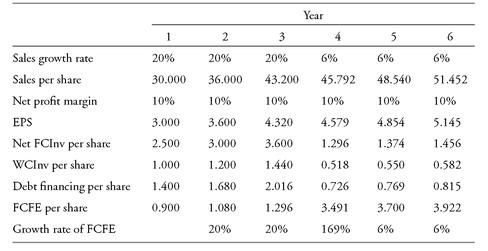
In Exhibit 4-15, sales are shown to grow at 20 percent annually for the first three years and then at 6 percent thereafter. Profits, which are 10 percent of sales, grow at the same rates. The net investments in fixed capital and working capital are, respectively, 50 percent of the increase in sales and 20 percent of the increase in sales. New debt financing equals 40 percent of the total increase in net fixed capital and working capital. FCFE is EPS minus the net investment in fixed capital per share minus the investment in working capital per share plus the debt financing per share.
Notice that FCFE grows by 20 percent annually for the first three years (i.e., between t = 0 and t = 3). Then, between years 3 and 4, when the sales growth rate drops from 20 percent to 6 percent, FCFE increases substantially. In fact, FCFE increases by 169 percent from year 3 to year 4. This large increase in FCFE occurs because profits grow at 6 percent but the investments in capital equipment and working capital (and the increase in debt financing) drop substantially from the previous year. In years 5 and 6 in Exhibit 4-15, sales, profit, investments, financing, and FCFE are all shown to grow at 6 percent.
The stock value is the present value of the first three years’ FCFE plus the present value of the terminal value of the FCFE from years 4 and later. The terminal value is
The present values are
The estimated value of this stock is € 40.98 per share.
As mentioned previously, the terminal value may account for a large portion of the value of a stock. In the case of TechnoSchaft, the present value of the terminal value is € 38.415 out of a total value of € 40.98. The present value (PV) of the terminal value is almost 94 percent of the total value of TechnoSchaft stock.
4.3.2. Declining Growth Rate in Stage 1 and Constant Growth in Stage 2
Growth rates usually do not drop precipitously as they do between the stages in the two-stage model just described, but growth rates can decline over time for many reasons. Sometimes a small company has a high growth rate that is not sustainable as its market share increases. A highly profitable company may attract competition that makes it harder for the company to sustain its high profit margins.
In this section, we present two examples of the two-stage model with declining growth rates in stage 1. In the first example, the growth rate of EPS declines during stage 1. As a company’s profitability declines and the company is no longer generating high returns, the company will usually reduce its net new investment in operating assets. The debt financing accompanying the new investments will also decline. Many highly profitable, growing companies have negative or low free cash flows. Later, when growth in profits slows, investments will tend to slow and the company will experience positive cash flows. Of course, the negative cash flows incurred in the high-growth stage help determine the cash flows that occur in future years.
Example 4-17 models FCFE per share as a function of EPS that declines constantly during stage 1. Because of declining earnings growth rates, the company in the example also reduces its new investments over time. The value of the company depends on these free cash flows, which are substantial after the high-growth (and high-profitability) period has largely elapsed.
The FCFE in Example 4-17 was based on forecasts of future EPS. Analysts often model a company by forecasting future sales and then estimating the profits, investments, and financing associated with those sales levels. For large companies, analysts may estimate the sales, profitability, investments, and financing for each division or large subsidiary. Then they aggregate the free cash flows for all of the divisions or subsidiaries to get the free cash flow for the company as a whole.
EXAMPLE 4-17 A Two-Stage FCFE Valuation Model with Declining Net Income Growth in Stage 1
Vishal Noronha needs to prepare a valuation of Sindhuh Enterprises. Noronha has assembled the following information for his analysis. It is now the first day of 2008.
• EPS for 2007 is $2.40.
• For the next five years, the growth rate in EPS is given in the following table. In 2012 and beyond, the growth rate will be 7 percent.

• Net investments in fixed capital (net of depreciation) for the next five years are given in the following table. After 2012, capital expenditures are expected to grow at 7 percent annually.

• The investment in working capital each year will equal 50 percent of the net investment in capital items.
• Thirty percent of the net investment in fixed capital and investment in working capital will be financed with new debt financing.
• Current market conditions dictate a risk-free rate of 6.0 percent, an equity risk premium of 4.0 percent, and a beta of 1.10 for Sindhuh Enterprises.
1. What is the per-share value of Sindhuh Enterprises on the first day of 2008?
2. What should be the trailing P/E on the first day of 2008 and the first day of 2012?
Solution to 1: The required return for Sindhuh should be
r = E(Ri) = RF + βi[E(RM )- RF ] = 6% + 1.1 (4%) = 10.4%
The FCFEs for the company for years 2008 through 2012 are given in Exhibit 4-16.
EXHIBIT 4-16 FCFE Estimates for Sindhuh Enterprises (per-share data in U.S. dollars)


Earnings are $2.40 in 2007. Earnings increase each year by the growth rate given in the table. Net capital expenditures (capital expenditures minus depreciation) are the amounts that Noronha assumed. The increase in working capital each year is 50 percent of the increase in net capital expenditures. Debt financing is 30 percent of the total outlays for net capital expenditures and working capital each year. The FCFE each year is net income minus net capital expenditures minus increase in working capital plus new debt financing. Finally, for years 2008 through 2011, the present value of FCFE is found by discounting FCFE by the 10.4 percent required rate of return for equity.
After 2011, FCFE will grow by a constant 7 percent annually, so the constant growth FCFE valuation model can be used to value this cash flow stream. At the end of 2011, the value of the future FCFE is
To find the present value of V2011 as of the end of 2007, V2007, we discount V2011 at 10.4 percent for four years:
The total present value of the company is the present value of the first four years’ FCFE plus the present value of the terminal value, or
Solution to 2: Using the estimated $78.73 stock value, we find that the trailing P/E at the beginning of 2008 is
At the beginning of 2012, the expected stock value is $110.56 and the previous year’s EPS is $4.494, so the trailing P/E at this time would be
After its high-growth phase has ended, the P/E for the company declines substantially.
Example 4 -18 is a two-stage FCFE model with declining sales growth rates in stage 1, with profits, investments, and financing keyed to sales. In stage 1, the growth rate of sales and the profit margin on sales both decline as the company matures and faces more competition and slower growth.
EXAMPLE 4-18 A Two-Stage FCFE Valuation Model with Declining Sales Growth Rates
Medina Werks, a manufacturing company headquartered in Canada, has a competitive advantage that will probably deteriorate over time. Analyst Flavio Torino expects this deterioration to be reflected in declining sales growth rates as well as declining profit margins. To value the company, Torino has accumulated the following information:
• Current sales are C$600 million. Over the next six years, the annual sales growth rate and the net profit margin are projected to be as follows: Beginning in year 6, the 7 percent sales growth rate and 10 percent net profit margin should persist indefinitely.
Beginning in year 6, the 7 percent sales growth rate and 10 percent net profit margin should persist indefinitely.

• Capital expenditures (net of depreciation) in the amount of 60 percent of the sales increase will be required each year.
• Investments in working capital equal to 25 percent of the sales increase will also be required each year.
• Debt financing will be used to fund 40 percent of the investment in net capital items and working capital.
• The beta for Medina Werks is 1.10; the risk-free rate of return is 6.0 percent; the equity risk premium is 4.5 percent.
• The company has 70 million outstanding shares.
1. What is the estimated total market value of equity?
2. What is the estimated value per share?
Solution to 1: The required return for Sindhuh should be
The annual sales and net profit can be readily found as shown in Exhibit 4-17.
EXHIBIT 4-17 FCFE Estimates for Medina Werks (C$ in millions)
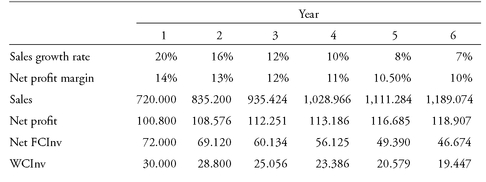

As can be seen, sales are expected to increase each year by a declining sales growth rate. Net profit each year is the year’s net profit margin times the year’s sales. Capital investment (net of depreciation) equals 60 percent of the sales increase from the previous year. The investment in working capital is 25 percent of the sales increase from the previous year. The debt financing each year is equal to 40 percent of the total net investment in capital items and working capital for that year. FCFE is net income minus the net capital investment minus the working capital investment plus the debt financing. The present value of each year’s FCFE is found by discounting FCFE at the required rate of return for equity, 10.95 percent.
In year 6 and beyond, Torino predicts sales to increase at 7 percent annually. Net income will be 10 percent of sales, so net profit will also grow at a 7 percent annual rate. Because they are pegged to the 7 percent sales increase, the investments in capital items and working capital and debt financing will also grow at the same 7 percent rate. The amounts in year 6 for net income, investment in capital items, investment in working capital, debt financing, and FCFE will grow at 7 percent.
The terminal value of FCFE in year 6 and beyond is
The present value of this amount is
The estimated total market value of the firm is the present value of FCFE for years 1 through 5 plus the present value of the terminal value:
Solution to 2: Dividing C$1,401.69 million by the 70 million outstanding shares gives the estimated value per share of C$20.02.
4.4. Three-Stage Growth Models
Three-stage models are a straightforward extension of the two-stage models. One common version of a three-stage model is to assume a constant growth rate in each of the three stages. The growth rates could be for sales, profits, and investments in fixed and working capital; external financing could be a function of the level of sales or changes in sales. A simpler model would apply the growth rate to FCFF or FCFE.
A second common model is a three-stage model with constant growth rates in stages 1 and 3 and a declining growth rate in stage 2. Again, the growth rates could be applied to sales or to FCFF or FCFE. Although future FCFF and FCFE are unlikely to follow the assumptions of either of these three-stage growth models, analysts often find such models to be useful approximations.
EXAMPLE 4-19 A Three-Stage FCFF Valuation Model with Declining Growth in Stage 2
Charles Jones is evaluating Reliant Home Furnishings by using a three-stage growth model. He has accumulated the following information:
• Current FCFF = $745 million
• Outstanding shares = 309.39 million
• Equity beta = 0.90, risk-free rate = 5.04 percent; equity risk premium = 5.5 percent
• Cost of debt = 7.1 percent
• Marginal tax rate = 34 percent
• Capital structure = 20 percent debt, 80 percent equity
• Long-term debt = $1.518 billion
• Growth rate of FCFF =
• 8.8 percent annually in stage 1, years 1-4
• 7.4 percent in year 5, 6.0 percent in year 6, 4.6 percent in year 7
• 3.2 percent in year 8 and thereafter From the information that Jones has accumulated, estimate the following:
1. WACC.
2. Total value of the firm.
3. Total value of equity.
4. Value per share.
Solution to 1: The required return for equity is WACC is
WACC is
Solution to 2: Exhibit 4-18 displays the projected FCFF for the next eight years and the present value of each FCFF discounted at 8.93 percent.
EXHIBIT 4-18 Forecasted FCFF for Reliant Home Furnishings

The terminal value at the end of year 7 is

The present value of this amount discounted at 8.93 percent for seven years is
The total present value of the first seven years of FCFF is $5,097 million. The total value of the firm is 12,304 + 5,097 = $17,401 million.
Solution to 3: The value of equity is the value of the firm minus the market value of debt:
Solution to 4: Dividing the equity value by the number of shares yields the value per share:
Example 4-19 is a three-stage FCFF valuation model with declining growth rates in stage 2. The model directly forecasts FCFF instead of deriving FCFF from a more complicated model that estimates cash flow from operations and investments in fixed and working capital.
The next section discusses an important technical issue, the treatment of nonoperating assets in valuation.
5. NONOPERATING ASSETS AND FIRM VALUE
Free cash flow valuation focuses on the value of assets that generate or are needed to generate operating cash flows. If a company has significant nonoperating assets, such as excess cash,93 excess marketable securities, or land held for investment, then analysts often calculate the value of the firm as the value of its operating assets (e.g., as estimated by FCFF valuation) plus the value of its nonoperating assets:
Value of firm = Value of operating assets + Value of nonoperating assets (4-18)
In general, if any company asset is excluded from the set of assets being considered in projecting a company’s future cash flows, the analyst should add that omitted asset’s estimated value to the cash flows-based value estimate. Some companies have substantial noncurrent investments in stocks and bonds that are not operating subsidiaries but, rather, financial investments. These investments should be reflected at their current market value. Those securities reported at book values on the basis of accounting conventions should be revalued to market values.
6. SUMMARY
Discounted cash flow models are widely used by analysts to value companies.
• Free cash flow to the firm (FCFF) and free cash flow to equity (FCFE) are the cash flows available to, respectively, all of the investors in the company and to common stockholders.
• Analysts like to use free cash flow (either FCFF or FCFE) as the return
• If the company is not paying dividends.
• If the company pays dividends but the dividends paid differ significantly from the company’s capacity to pay dividends.
• If free cash flows align with profitability within a reasonable forecast period with which the analyst is comfortable.
• If the investor takes a control perspective.
• The FCFF valuation approach estimates the value of the firm as the present value of future FCFF discounted at the weighted average cost of capital:

The value of equity is the value of the firm minus the value of the firm’s debt:
Dividing the total value of equity by the number of outstanding shares gives the value per share.
The WACC formula is
• The value of the firm if FCFF is growing at a constant rate is
• With the FCFE valuation approach, the value of equity can be found by discounting FCFE at the required rate of return on equity, r :
Dividing the total value of equity by the number of outstanding shares gives the value per share.
• The value of equity if FCFE is growing at a constant rate is
• FCFF and FCFE are frequently calculated by starting with net income:
• FCFF and FCFE are related to each other as follows:
• FCFF and FCFE can be calculated by starting from cash flow from operations:
• FCFF can also be calculated from EBIT or EBITDA: FCFE can then be found by using FCFE = FCFF - Int(1 - Tax rate) + Net borrowing.
FCFE can then be found by using FCFE = FCFF - Int(1 - Tax rate) + Net borrowing.
• Finding CFO, FCFF, and FCFE may require careful interpretation of corporate financial statements. In some cases, the needed information may not be transparent.
• Earnings components such as net income, EBIT, EBITDA, and CFO should not be used as cash flow measures to value a firm. These earnings components either double-count or ignore parts of the cash flow stream.
• FCFF or FCFE valuation expressions can be easily adapted to accommodate complicated capital structures, such as those that include preferred stock.
• A general expression for the two-stage FCFF valuation model is

• A general expression for the two-stage FCFE valuation model is
• One common two-stage model assumes a constant growth rate in each stage, and a second common model assumes declining growth in stage 1 followed by a long-run sustainable growth rate in stage 2.
• To forecast FCFF and FCFE, analysts build a variety of models of varying complexity. A common approach is to forecast sales, with profitability, investments, and financing derived from changes in sales.
• Three-stage models are often considered to be good approximations for cash flow streams that, in reality, fluctuate from year to year.
• Nonoperating assets, such as excess cash and marketable securities, noncurrent investment securities, and nonperforming assets, are usually segregated from the company’s operating assets. They are valued separately and then added to the value of the company’s operating assets to find total firm value.
PROBLEMS
1. Indicate the effect on this period’s FCFF and FCFE of a change in each of the items listed here. Assume a $100 increase in each case and a 40 percent tax rate.
a. Net income.
b. Cash operating expenses.
c. Depreciation.
d. Interest expense.
e. EBIT.
f. Accounts receivable.
g. Accounts payable.
h. Property, plant, and equipment.
i. Notes payable.
j. Cash dividends paid.
k. Proceeds from issuing new common shares.
l. Common shares repurchased.
2. LaForge Systems, Inc. has net income of $285 million for the year 2008. Using information from the company’s financial statements given here, show the adjustments to net income that would be required to find:
a. FCFF.
b. FCFE.
c. In addition, show the adjustments to FCFF that would result in FCFE.
| LaForge Systems, Inc. | ||
| Balance Sheet | ||
| In millions | 31 December 2007 | 2008 |
| Assets | ||
| Current assets | ||
| Cash and equivalents | $210 | $248 |
| Accounts receivable | 474 | 513 |
| Inventory | 520 | 564 |
| Total current assets | 1,204 | 1,325 |
| Gross fixed assets | 2,501 | 2,850 |
| Accumulated depreciation | (604) | (784) |
| Net fixed assets | 1,897 | 2,066 |
| Total assets | $3,101 | $3,391 |
| Liabilities and shareholders’ equity | ||
| Current liabilities | ||
| Accounts payable | $295 | $317 |
| Notes payable | 300 | 310 |
| Accrued taxes and expenses | 76 99 | |
| Total current liabilities | 671 | 726 |
| Long-term debt | 1,010 | 1,050 |
| Common stock | 50 | 50 |
| Additional paid-in capital | 300 | 300 |
| Retained earnings | 1,070 | 1,265 |
| Total shareholders’ equity | 1,420 | 1,615 |
| Total liabilities and shareholders’ equity | $3,101 | $3,391 |
| Statement of Income | ||
| In millions, except per-share data | 31 December 2008 | |
| Total revenues | $2,215 | |
| Operating costs and expenses | 1,430 | |
| EBITDA | 785 | |
| Depreciation | 180 | |
| EBIT | 605 | |
| In terest expense | 130 | |
| Income before tax | 475 | |
| Taxes (at 40 percent) | 190 | |
| Net income | 285 | |
| Dividends | 90 | |
| Addition to retained earnings | 195 | |
| Statement of Cash Flows | ||
| In millions | 31 December 2008 | |
| Operating activities | ||
| Net income | $285 | |
| Adjustments | ||
| Depreciation | 180 | |
| Changes in working capital | ||
| Accounts receivable | (39) | |
| Inventories | (44) | |
| Accounts payable | 22 | |
| Accrued taxes and expenses | 23 | |
| Cash provided by operating activities | $427 | |
| Investing activities | ||
| Purchases of fixed assets | 349 | |
| Cash used for investing activities | $349 | |
| Financing activities | ||
| Notes payable | (10) | |
| Long-term financing issuances | (40) | |
| Common stock dividends | 90 | |
| Cash used for financing activities | $40 | |
| Cash and equivalents increase (decrease) | 38 | |
| Cash and equivalents at beginning of year | 210 | |
| Cash and equivalents at end of year | $248 | |
| Supplemental cash flow disclosures | ||
| In terest paid | $130 | |
| Income taxes paid | $190 | |
| Note: The Statement of Cash Flows shows the use of a convention by which the positive numbers of $349 and $40 for cash used for investing activities and cash used for financing activities, respectively, are understood to be subtractions, because “cash used” is an outflow. | ||
3. For LaForge Systems, whose financial statements are given in problem 2, show the adjustments from the current levels of CFO (which is $427 million), EBIT ($605 million), and EBITDA ($785 million) to find
a. FCFF.
b. FCFE.
4. The term free cash flow is frequently applied to cash flows that differ from the definition for FCFF that should be used to value a firm. Two such definitions of free cash flow are given below. Compare these two definitions for free cash flow with the technically correct definition of FCFF used in the text.
a. FCF = Net income + Depreciation and amortization - Cash dividends - Capital expenditures.
b. FCF = Cash flow from operations (from the statement of cash flows) - Capital expenditures.
5. Proust Company has FCFF of $1.7 billion and FCFE of $1.3 billion. Proust’s WACC is 11 percent, and its required rate of return for equity is 13 percent. FCFF is expected to grow forever at 7 percent, and FCFE is expected to grow forever at 7.5 percent. Proust has debt outstanding of $15 billion.
a. What is the total value of Proust’s equity using the FCFF valuation approach?
b. What is the total value of Proust’s equity using the FCFE valuation approach?
6. Quinton Johnston is evaluating TMI Manufacturing Company, Ltd., which is headquartered in Taiwan. In 2008, when Johnston is performing his analysis, the company is unprofitable. Furthermore, TMI pays no dividends on its common shares. Johnston decides to value TMI Manufacturing by using his forecasts of FCFE. Johnston gathers the following facts and assumptions:
• The company has 17.0 billion shares outstanding.
• Sales will be $5.5 billion in 2009, increasing at 28 percent annually for the next four years (through 2013).
• Net income will be 32 percent of sales.
• Investment in fixed assets will be 35 percent of sales; investment in working capital will be 6 percent of sales; depreciation will be 9 percent of sales.
• 20 percent of the investment in assets will be financed with debt.
• Interest expenses will be only 2 percent of sales.
• The tax rate will be 10 percent. TMI Manufacturing’s beta is 2.1; the risk-free government bond rate is 6.4 percent; the equity risk premium is 5.0 percent.
• At the end of 2013, Johnston projects TMI will sell for 18 times earnings.
What is the value of one ordinary share of TMI Manufacturing Company?
7. Do Pham is evaluating Phaneuf Accelerateur by using the FCFF and FCFE valuation approaches. Pham has collected the following information (currency in euro):
• Phaneuf has net income of €250 million, depreciation of €90 million, capital expenditures of €170 million, and an increase in working capital of €40 million.
• Phaneuf will finance 40 percent of the increase in net fixed assets (capital expenditures less depreciation) and 40 percent of the increase in working capital with debt financing.
• Interest expenses are €150 million. The current market value of Phaneuf ’s outstanding debt is €1,800 million.
• FCFF is expected to grow at 6.0 percent indefinitely, and FCFE is expected to grow at 7.0 percent.
• The tax rate is 30 percent.
• Phaneuf is financed with 40 percent debt and 60 percent equity. The before-tax cost of debt is 9 percent, and the before-tax cost of equity is 13 percent.
• Phaneuf has 10 million outstanding shares.
a. Using the FCFF valuation approach, estimate the total value of the firm, the total market value of equity, and the per-share value of equity.
b. Using the FCFE valuation approach, estimate the total market value of equity and the per-share value of equity.
8. PHB Company currently sells for $32.50 per share. In an attempt to determine whether PHB is fairly priced, an analyst has assembled the following information:
• The before-tax required rates of return on PHB debt, preferred stock, and common stock are, respectively, 7.0 percent, 6.8 percent, and 11.0 percent.
• The company’s target capital structure is 30 percent debt, 15 percent preferred stock, and 55 percent common stock.
• The market value of the company’s debt is $145 million, and its preferred stock is valued at $65 million.
• PHB’s FCFF for the year just ended is $28 million. FCFF is expected to grow at a constant rate of 4 percent for the foreseeable future.
• The tax rate is 35 percent.
• PHB has 8 million outstanding common shares.
What is PHB’s estimated value per share? Is PHB’s stock underpriced?
9. Watson Dunn is planning to value BCC Corporation, a provider of a variety of industrial metals and minerals. Dunn uses a single -stage FCFF approach. The financial information Dunn has assembled for his valuation is as follows:
• The company has 1,852 million shares outstanding.
• The market value of its debt is $3.192 billion.
• The FCFF is currently $1.1559 billion.
• The equity beta is 0.90; the equity risk premium is 5.5 percent; the risk-free rate is 5.5 percent.
• The before-tax cost of debt is 7.0 percent.
• The tax rate is 40 percent.
• To calculate WACC, he will assume the company is financed 25 percent with debt.
• The FCFF growth rate is 4 percent.
Using Dunn’s information, calculate the following:
a. WACC.
b. Value of the firm.
c. Total market value of equity.
d. Value per share.
10. Kenneth McCoin is valuing McInish Corporation and performing a sensitivity analysis on his valuation. He uses a single-stage FCFE growth model. The base-case values for each of the parameters in the model are given, together with possible low and high estimates for each variable, in the following table. 

a. Use the base -case values to estimate the current value of McInish Corporation.
b. Calculate the range of stock prices that would occur if the base-case value for FCFE0 were replaced by the low estimate and the high estimate for FCFE0. Similarly, using the base-case values for all other variables, calculate the range of stock prices caused by using the low and high values for beta, the risk-free rate, the equity risk premium, and the growth rate. Based on these ranges, rank the sensitivity of the stock price to each of the five variables.
11. An aggressive financial planner who claims to have a superior method for picking undervalued stocks is courting one of your clients. The planner claims that the best way to find the value of a stock is to divide EBITDA by the risk-free bond rate. The planner is urging your client to invest in NewMarket, Inc. The planner says that NewMarket’s EBITDA of $1,580 million divided by the long-term government bond rate of 7 percent gives a total value of $22,571.4 million. With 318 million outstanding shares, NewMarket’s value per share found by using this method is $70.98. Shares of NewMarket currently trade for $36.50.
a. Provide your client with an alternative estimate of NewMarket’s value per share based on a two-stage FCFE valuation approach. Use the following assumptions:
• Net income is currently $600 million. Net income will grow by 20 percent annually for the next three years.
• The net investment in operating assets (capital expenditures less depreciation plus investment in working capital) will be $1,150 million next year and grow at 15 percent for the following two years.
• Forty percent of the net investment in operating assets will be financed with net new debt financing.
• NewMarket’s beta is 1.3; the risk -free bond rate is 7 percent; the equity risk premium is 4 percent.
• After three years, the growth rate of net income will be 8 percent and the net investment in operating assets (capital expenditures minus depreciation plus increase in working capital) each year will drop to 30 percent of net income.
• Debt is, and will continue to be, 40 percent of total assets.
• NewMarket has 318 million shares outstanding.
b. Criticize the valuation approach that the aggressive financial planner used.
12. Bron has EPS of $3.00 in 2002 and expects EPS to increase by 21 percent in 2003. Earnings per share are expected to grow at a decreasing rate for the following five years, as shown in the following table.

In 2008, the growth rate will be 6 percent and is expected to stay at that rate thereafter. Net capital expenditures (capital expenditures minus depreciation) will be $5.00 per share in 2002 and then follow the pattern predicted in the table. In 2008, net capital expenditures are expected to be $1.50 and will then grow at 6 percent annually. The investment in working capital parallels the increase in net capital expenditures and is predicted to equal 25 percent of net capital expenditures each year. In 2008, investment in working capital will be $0.375 and is predicted to grow at 6 percent thereafter. Bron will use debt financing to fund 40 percent of net capital expenditures and 40 percent of the investment in working capital. The required rate of return for Bron is 12 percent.
Estimate the value of a Bron share using a two-stage FCFE valuation approach.
13. The management of Telluride, an international diversified conglomerate based in the United States, believes that the recent strong performance of its wholly owned medical supply subsidiary, Sundanci, has gone unnoticed. To realize Sundanci’s full value, Telluride has announced that it will divest Sundanci in a tax-free spin-off.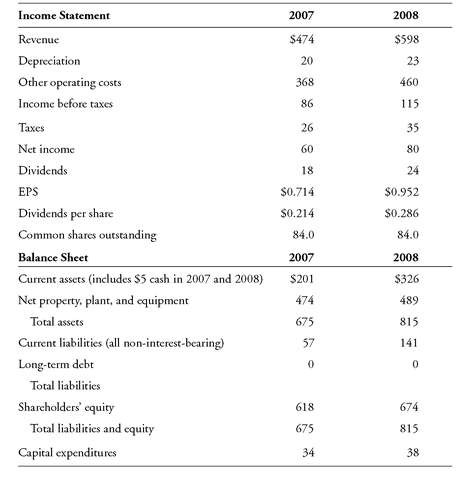

Sue Carroll, CFA, is director of research at Kesson and Associates. In developing an investment recommendation for Sundanci, Carroll has gathered the information shown in Exhibits 4-19 and 4-20.
EXHIBIT 4-19 Sundanci Actual 2007 and 2008 Financial Statements for Fiscal Years Ending 31 May (dollars in millions except per-share data)

EXHIBIT 4-20 Selected Financial Information

Abbey Naylor, CFA, has been directed by Carroll to determine the value of Sundanci’s stock by using the FCFE model. Naylor believes that Sundanci’s FCFE will grow at 27 percent for two years and at 13 percent thereafter. Capital expenditures, depreciation, and working capital are all expected to increase proportionately with FCFE.
a. Calculate the amount of FCFE per share for 2008 by using the data from Exhibit 4-19.
b. Calculate the current value of a share of Sundanci stock based on the two-stage FCFE model.
c. Describe limitations that the two-stage DDM and FCFE models have in common.
14. John Jones, CFA, is head of the research department of Peninsular Research. One of the companies he is researching, Mackinac Inc., is a U.S.-based manufacturing company. Mackinac has released the June 2007 financial statements shown in Exhibits 4-21, 4-22, and 4-23.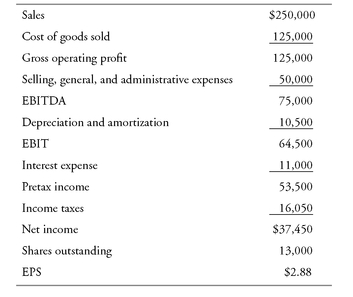

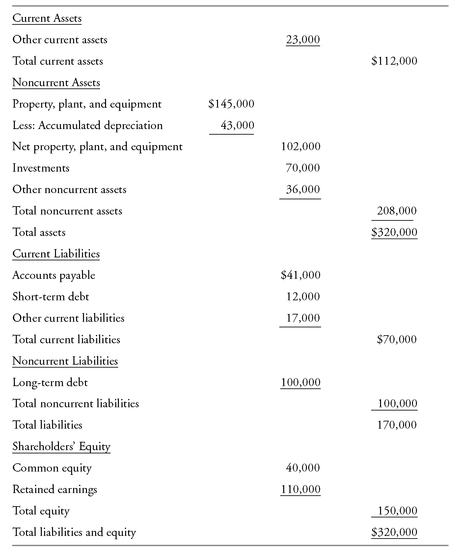
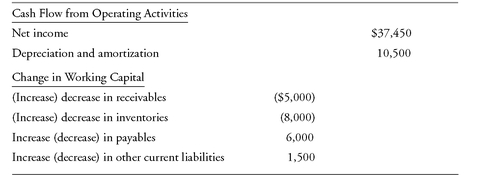
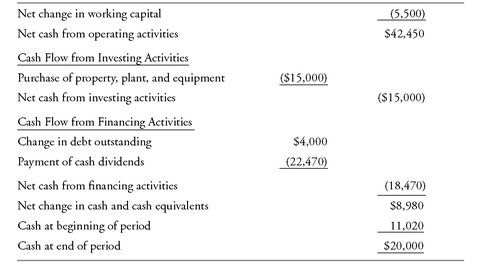
EXHIBIT 4-21 Mackinac Inc. Annual Income Statement 30 June 2007 (in thousands, except per-share data)

EXHIBIT 4-22 Mackinac Inc. Balance Sheet 30 June 2007 (in thousands)

EXHIBIT 4-23 Mackinac Inc. Cash Flow Statement 30 June 2007 (in thousands)



Mackinac has announced that it has finalized an agreement to handle North American production of a successful product currently marketed by a company headquartered outside North America. Jones decides to value Mackinac by using the DDM and FCFE models. After reviewing Mackinac’s financial statements and forecasts related to the new production agreement, Jones concludes the following:
• Mackinac’s earnings and FCFE are expected to grow 17 percent a year over the next three years before stabilizing at an annual growth rate of 9 percent.
• Mackinac will maintain the current payout ratio.
• Mackinac’s beta is 1.25.
• The government bond yield is 6 percent, and the market equity risk premium is 5 percent.
a. Calculate the value of a share of Mackinac’s common stock by using the two-stage DDM.
b. Calculate the value of a share of Mackinac’s common stock by using the two-stage FCFE model.
c. Jones is discussing with a corporate client the possibility of that client acquiring a 70 percent interest in Mackinac. Discuss whether the DDM or FCFE model is more appropriate for this client’s valuation purposes.
15. SK Telecom Company is a cellular telephone paging and computer communication services company in Seoul, South Korea. The company is traded on the Korea, New York, and London stock exchanges (NYSE: SKM). Sol Kim has estimated the normalized FCFE for SK Telecom to be 1,300 Korean won (per share) for the year just ended. The real country return for South Korea is 6.50 percent. To estimate the required return for SK Telecom, Kim makes the following adjustments to the real country return: an industry adjustment of +0.60 percent, a size adjustment of -0.10 percent, and a leverage adjustment of +0.25 percent. The long-term real growth rate for South Korea is estimated to be 3.5 percent, and Kim expects the real growth rate of SK Telecom to track the country rate.
a. What is the real required rate of return for SK Telecom?
b. Using the single-stage FCFE valuation model and real values for the discount rate and FCFE growth rate, estimate the value of one share of SK Telecom.
16. Lawrence McKibben is preparing a valuation of QuickChange Auto Centers, Inc. McKibben has decided to use a three-stage FCFE valuation model and the following estimates. The FCFE per share for the current year is $0.75. The FCFE is expected to grow at 10 percent for next year, then at 26 percent annually for the following three years, and then at 6 percent in year 5 and thereafter. QuickChange’s estimated beta is 2.00, and McKibben believes that current market conditions dictate a 4.5 percent risk-free rate of return and a 5.0 percent equity risk premium. Given McKibben’s assumptions and approach, estimate the value of a share of QuickChange.
17. Clay Cooperman has valued the operating assets of Johnson Extrusion at $720 million. The company also has short-term cash and securities with a market value of $60 million that are not needed for Johnson’s operations. The noncurrent investments have a book value of $30 million and a market value of $45 million. The company also has an overfunded pension plan, with plan assets of $210 million and plan liabilities of $170 million. Johnson Extrusion has $215 million of notes and bonds outstanding and 100 million outstanding shares. What is the value per share of Johnson Extrusion stock?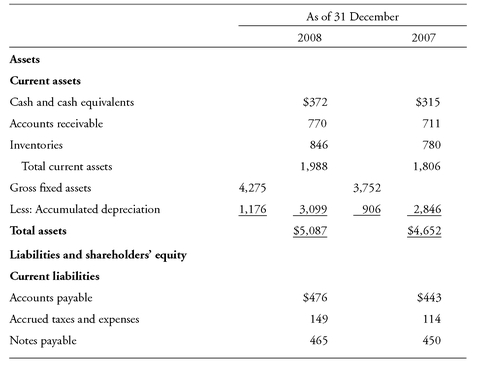
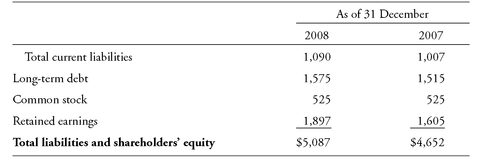
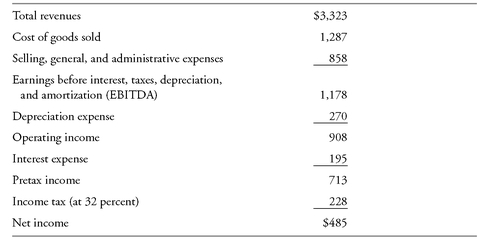
Use the following information to answer Questions 18 through 23.
Ryan Leigh is preparing a presentation that analyzes the valuation of the common stock of two companies under consideration as additions to his firm’s recommended list, Emerald Corporation and Holt Corporation. Leigh has prepared preliminary valuations of both companies using an FCFE model and is also preparing a value estimate for Emerald using a dividend discount model. Holt’s 2007 and 2008 financial statements, contained in Exhibits 4-24 and 4-25, are prepared in accordance with U.S. GAAP.
EXHIBIT 4-24 Holt Corporation Consolidated Balance Sheets (US$ millions)

EXHIBIT 4-25 Holt Corporation Consolidated Income Statement for the Year Ended 31 December 2008 (US$ millions)


Leigh presents his valuations of the common stock of Emerald and Holt to his supervisor, Alice Smith. Smith has the following questions and comments:
• “I estimate that Emerald’s long-term expected dividend payout rate is 20 percent and its return on equity is 10 percent over the long-term.”
• “Why did you use an FCFE model to value Holt’s common stock? Can you use a DDM instead?”
• “ How did Holt’s FCFE for 2008 compare with its FCFF for the same year? I recommend you use an FCFF model to value Holt’s common stock instead of using an FCFE model because Holt has had a history of leverage changes in the past.”
• “In the past three years, about 5 percent of Holt’s growth in FCFE has come from decreases in inventory.”
Leigh responds to each of Smith’s points as follows:
• “I will use your estimates and calculate Emerald’s long-term, sustainable dividend growth rate.”
• “ There are two reasons why I used the FCFE model to value Holt’s common stock instead of using a DDM. The first reason is that Holt’s dividends have differed significantly from its capacity to pay dividends. The second reason is that Holt is a takeover target and once the company is taken over, the new owners will have discretion over the uses of free cash flow.”
• “I will calculate Holt’s FCFF for 2008 and estimate the value of Holt’s common stock using an FCFF model.”
• “ Holt is a growing company. In forecasting either Holt’s FCFE or FCFF growth rates, I will not consider decreases in inventory to be a long-term source of growth.”
18. Which of the following long-term FCFE growth rates is most consistent with the facts and stated policies of Emerald?
a. 5 percent or lower.
b. 2 percent or higher.
c. 8 percent or higher.
19. Do the reasons provided by Leigh support his use of the FCFE model to value Holt’s common stock instead of using a DDM?
a. Yes.
b. No, because Holt’s dividend situation argues in favor of using the DDM.
c. No, because FCFE is not appropriate for investors taking a control perspective.
20. Holt’s FCFF (in millions) for 2008 is closest to:
a. $308.
b. $370.
c. $422.
21. Holt’s FCFE (in millions) for 2008 is closest to:
a. $175.
b. $250.
c. $364.
22. Leigh’s comment about not considering decreases in inventory to be a source of long-term growth in free cash flow for Holt is:
a. Inconsistent with a forecasting perspective.
b. Mistaken because decreases in inventory are a use rather than a source of cash.
c. Consistent with a forecasting perspective because inventory reduction has a limit, particularly for a growing firm.
23. Smith’s recommendation to use an FCFF model to value Holt is:
a. Logical, given the prospect of Holt changing capital structure.
b. Not logical because an FCFF model is used only to value the total firm.
c. Not logical because FCFE represents a more direct approach to free cash flow valuation.
..................Content has been hidden....................
You can't read the all page of ebook, please click here login for view all page.
